Original article by David Bocquelet, 25 december 2013

The Tiger was a formidable machine that pushed the boundaries of armored warfare and forced the Allies to devise better tanks. It powerfully symbolized all the might of the Nazi war machine, as dreamed off by Hitler, and later turned through propaganda into a "Wunderwaffe" (wonder weapon) in a mostly defensive war. The Tiger, like all new tanks, had teething problems at first and it was never an easy tank to maintain, but it was always deadly effective (with a 10:1 up to 19:1 kill ratio), earning a capital of fear that was unrivaled during the war.
Allied crews found themselves hopeless with their inadequate machines, having to improvise costly tactics to deal with it. The Tiger gave fame to a few WWII tank aces, like Michael Wittman, something rarely heard of before, since the life expectancy of a tank crew was always quite shorter than that of fighter pilots.
Maybach dismissed a 16-cylinder as too long to fit in an engine compartment, so only a scaled-up 12-cylinder could be conceived, although it required a tremendous amount of development to reach the targeted output of 600 hp. Later, discussions led to the conclusion that only a 16-cylinder could provide the 700 hp needed for a 30-40 ton tank. This was still optimistic, given the fact that in 1936 Maybach was still struggling to produce its first compact 300 hp engine.
Wa Pruef 6 also studied the use of an aircraft engine, characterized by high-torque and low rpm, but this posed the obligation of redesigning many components of the drive train, which would mean sacrificing other vital aspects to stay within the 30 tons limit.

It was propelled by a Maybach 120 TR, with varlorex transmission and cletract system of three-stage steering gears allowing a maximum speed of 35 km/h (22 mph). There were also six double road wheels per side, suspended by torsion arms. The track was center guided, with a 300 mm (11.8 in) pitch. The DW 2 was similar but with automotive improvements made to the steering gear, final drive, parking brakes, torsion bars, and having the tracks decreased to a 260 mm (10.2 in) pitch and changed drive sprockets. Both weighed 30 metric tons and were capable of 35 km/h (22 mph).

On the Krupp side, a conceptual preliminary design for a turret (AF30304) was sent on 22 February 1937. Dr. Olbricht from Wa Pruef 6 informed Krupp of various points for the definitive design in March 1937, notably the 1500 mm (4.92 ft) turret ring, 50 mm (1.96 in) thick turret walls, plus 20 mm (0.79 in) mantlet, new ball bearing, and adapted elevating mechanism, but no electric traverse.
A prototype had to be produced directly, bypassing a wooden mock-up stage. Finally, on 24 June 1938, Wa Pruef 6 awarded Krupp a contract for a trial turret. In April 1939, modifications were requested and a schedule required the completion of the turret until May, 26, 1939, which had to be then shipped to Magdeburg, to be compared to that of a Panzer IV.
Henschel devised a new chassis for this purpose, with all the lessons retained from the DWs. It featured a new Maybach HL 116 engine, new drivetrain and, most importantly, seven pairs of interleaved wheels (Geschachelte), meant to distribute the 32 tons of the tank and to reduce the ground pressure.
At the same time Krupp was awarded the construction of an armored test hull, to be delivered at Kummersdorf on 23 April 1940. The new construction involved dropping the vertical joint assembly, for new PP792 armor plates. However, this hull was not delivered until September 1940, and tests involved only 37 mm (1.46 in) guns.Meanwhile, Maybach made available the new HL 190 and HL 150 (400 hp) engines, and well as new transmissions. Krupp designed a turret to match the VK 65.01, for better commonality, having a low profile, as the gun centerline was to be 335 mm (13.2 in) over the deck. Externally, it had many features identical to the Panzer IV turm. As requested, there was also a small oval hole for a rearward machine-gun, with an armored semi-disc which pivoted to close this weak point. A turret observation periscope was also to be provided.

On November, 19, 1939, it was agreed that Henschel would deliver three prototypes of the neu konstruktion armored chassis, from March to April 1940. In July 1940, Krupp was ordered to deliver a complete turret with the PP 739 armor plate. Later, eight armored hulls were contracted from Henschel, the last scheduled in October 1941, but in reality delivered on 30 November.
On 25 September 1942, Oberstleutnant Krekel from the Wa Pruef 6 ordered four new updated chassis to be used for driver training. Already, by November 1941, there were concerns about upgrading the main gun (following the encounters with the first KV-1s) to the long-barrel L/34, then the L/43. Krupp objected that this would have triggered further delays. Eventually, this prospect was dropped on January, 30, 1942. The eight VK 30.01 turrets would eventually be placed on the Atlantic wall from May to September 1944.
By mid-1940, Henschel was ordered to modify the BW Fahrgestell to mount the new Krupp 105 turret. At the same time, it was revised internally to accept the new Maybach HL 174, giving a 450 hp max output. The hull front had to be 80 mm (3.15 in) thick and the total weight was uplifted to 36 tons, sitting on interleaved wheels.
Eventually, on the 26th May of 1942, Hitler intervened to specify that the new heavy tank should have the frontal armor 100 mm (3.94 in) thick, and 60 mm (2.36 in) sides, and ordered six prototypes from Porsche and Henschel. Following this, Wa Pruef 6 remade the specifications. The turret now needed to accept the 75 mm (2.95 in) Waffe 725 (without muzzle brake) and, on 11 June 1942, notified Krupp to drop the 105 mm (4.13 in) project and convert the turret according to the new specifications.
By August, this was renamed "Tigersprogramm". Eventually, the sole VK 36.01 chassis was delivered in March 1942 for tests, after being equipped at the Maybach factory near Friedschafen. The original six turrets ordered from Krupp were turned, in the meantime, into turmstellungen (fixed turrets), but completion of the required modifications was never carried out.

The tracks were supported by two double return rollers on each side. Porsche was awarded with a contract for three armored hulls and a soft-steel one, which was only completed in July 1941. As early as March 1941, Krupp engaged itself to deliver six turrets equipped with the new 8.8 cm (3.46 in) KwK L/56. The unique Typ 100 chassis undergone thorough trials at Nibelungenwerke, and the program, then known as Leopard, changed its name into the Tiger.
The return rollers were dropped. The Porsche new heavy tank prototype was then designated VK 45.01 (P). In July 1941, Krupp was ordered to deliver a hundred hulls derived from the new prototype and the same number of turrets to be assembled at Nibelungenwerke. In turn, the company was ordered to deliver ten complete pre-series vehicles for tests by May 1942.
But the completion was later rushed to match Hitler's birthday in April. However, serious supply problems with automotive parts delayed the completion of the first unti; July 1942, then the nine others followed in small batches until October, when the official objective was the completion of 76 Tiger(P)s.

These delays were cut short by Hitler's decision to terminate the program, as the remaining 90 vehicles would be turned into Panzerjägers with the new 88 mm (3.46 in) L/72 gun. Later, these were known as the Sd.Kfz.182 Ferdinand/Elefant. The ten first VK 45.01 (P)s would see service with the test unit Schwere Panzer Abteilung Abt 503, and were known in short as the Tiger(P). Only one seems to have been used in action, a modified Panzer Befehlwagen (with a new set of long-range radios) in Ukraine, with Abteilung 653, from April to July 1944. Three other hulls were completed as Bergepanzer Tiger(P), and three others as Rammtigers. Eventually, four of these hulls will receive definitive turrets made by Krupp and were kept for tests in August 1943.
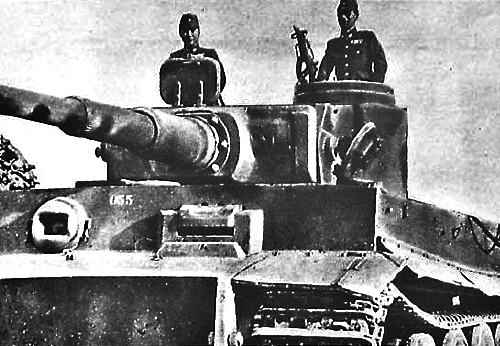
Japanese officers testing the Panzer VI Ausf.H1.
It was then decided that necessary numbers of the 7.5 cm (2.95 in) Waffe 0725 tapered-bore needed to be stockpiled, but the adaptation of the new 8.8 cm (3.46 in) KwK needed to be investigated.
The final armor thickness was fixed at 100 mm (3.94 in) frontal and 60 mm (2.36 in) sides and rear. However, in September 1941, the head of Wa Pruef 6, Oberst Fichtner, specified that the initial tapered-bore gun should be dropped and the lowered Porsche turret used instead, with the 8.8 cm (3.46 in) KwK, because of the tight schedule. The Henschel project was upgraded to a 45-ton program, and the cooling system and larger radiators had to be studied.
The side armor was increased to 80 mm (3.15 in), and extra rubber roadwheels were required to match the specified ground pressure for this 55-ton tank. The tracks had to be extended to 725 mm (2.38 ft), and pitch to 130 mm (5.11 in).
Other modifications included the side drive shafts, final drive, brakes, return rollers (abandoned), roadwheel arms, torsion bars, disc roadwheels, rubber tires, shock absorbers, bump stops, idler axes, and idler wheels, borrowed or copied and adapted from previous designs.
Four fuel tanks served the engine, with a total of 348 liters inside the two upper tanks (inside the side compartments, above the engine), and 186 liters in the two lower fuel tanks, on each side of the engine. An extra 8 mm (0.3 in) thick armor plate protected the upper tanks from any shell fragments/small caliber rounds which could penetrate the armor grill above them, bolted to the deck. These were protected by an extra wire mesh screen to prevent any dropping of an explosive charge by infantrymen.
This armor grill served as an air intake, to cool the air flowing through the radiators, located directly behind the fuel tanks, each actioned by two fans. The fan drive housing is connected to the engine compartment wall and watertight sealed. The fan area was protected by a heavy armor grill, through which the cooling air is exhausted. A wire mesh protection was bolted above to deflect any grenade. The transmission is cooled by a fan built into the firewall, between the fighting and engine compartments. The cooling air is pulled through a duct running along the hull floor and blown into the jackets surrounding the engine exhaust headers.
There was also a fire extinguisher system installed in the engine compartment, directed against the carburetor and fuel pumps, fully automatic, and using the CB agent. Thermostats activated the system when detecting a 120°C surge, and the discharge valve was opened for seven seconds. If that was not sufficient, another one would follow and potentially three others, as permitted by the three liter capacity CB flask.
External stowage composition and location changed continuously during production, but normally counted one tool box for track tools, a rear turret stowage bin for ten spare links and pins and a 1200x1800 mm (3.93x5.9 ft) tarp, a 15-ton steel jack with lifting housing, wooden block and fording crank, a centering guide and hand crank shaft for inertia starter, a 14 mm thick (0.5 in), 15 m long (49 feet) towing steel cable (or two 32 mm thick, 8 meters long), a 2-liter fire extinguisher, ax, shovel, spade, wire cutter, a 1.8 m long crowbar, a 6 kg sledge hammer, six cleaning rods and four tow shackles, plus a plate to cover the engine's air intake slit.
The fans were disconnected using the clutches. A procedure was applied before diving, to realign or close several butterfly valves in the exhaust cooling air, in order to deflect the flow to the schnorchel. Special heed was applied to the airtight seals on the fire wall, to avoid carbon monoxide gushing into the fighting compartment. A sump pump was also installed, to cope with any water leaking from inside the hull.
This turret was placed in the middle of the hull, and the tube, recoil cylinder and pneumatic recuperator were mounted in the gun carriage, which occupied a sizable portion of the interior. The gun had a MG 34 coaxial machine-gun, protected by a common mantlet. The gun could elevated by hand from -8 to 15 degrees of elevation. The forward weight of the gun and carriage was counterbalanced by a spring equilibrator. The spent casings were caught in a casing sack. Turret traverse was either hydraulically powered (auxiliary engine) or by hand. The Turmzielfernrhor TZF 9b binocular gun sight was fitted with a 12 hour azimuth indicator system, helping the commander to designate targets to the gunner.
The 100 mm (3.94 in) thick turret front plates were angled at 5° from the vertical, but the 80 mm (3.15 in) bent side plates were flat, taking the shape of a horseshoe, with the front closed by the upper and lower front plates. The leading edge of the turret roof was a 40 mm (1.57 in) thick plate, extending the turret width behind the upper front plate. The cast mantlet thickness was ranging from to 85 to 200 mm (3.35-7.87 in) depending of the angle. There were two vision slits on each forward turret side and two MP-klappen pistol ports on the rear sides. The cupola was mounted on the roof's left side and the ventilation fan to the rear.
The turret had three lifting studs for removal operations. The turret's support ring rested on the hull turret ball-bearing race, 2100 mm (6.89 ft) in diameter, comprising two grooved steel rings housing seventy-nine 40 mm (1.57 in) supporting ball bearings and the same number of 39 mm (1.56 in) spacing ball bearing. The gear ring was bolted to the armor hull and comprised 240 teeth selves for manual traverse drive. An inflatable rubber inner tube served to watertight seal the gap (when inflated), while water seeping into the ball bearing race was drained out by a tube sealed with a threaded cap. There was also a sealing ring, protecting from sand and mud.
The loader was on the right side, as the elevation mechanism, and the seat rested on the bridge. The gunner azimuth was mounted on his front left, on the turret ring, and served by a traverse mechanism. Both gunner and commander seats rested on the left of the bridge. The hydraulic drive controls were mounted to the left of the turret platform, connected by a drive shaft to the traverse mechanism of the turret ring. The turret platform was suspended by three massive supports fastened to the ring, gear housing and gun bridge support. The hull was accessible from below through a hinged hatch built in the platform floor.
Radio equipment comprised two sets for external communications, an ultra-short 10-watt FU-5 emitter (5-10 km/3.1-6.2 mi range) for tank-to-tank communications, coupled with a FU-2 receiver, but nine out of 15 tanks in each company of Tigers had only a FU-5. An intercom system was fitted, and four members of the crew had headsets with microphones. The loader wasn't equipped. Each company comprised a single modified Panzerbefehlswagen fitted with an extra equipment mounted in place of the turret machine-gun mount.
This comprised a FU-5/FU-8 (Sd.Kfz.267) and FU-5/FU-7 (Sd.Kfz.268). One of these was mounted in the hull, and both were suspended by rubber-cushion bands to the hull or turret. The latter one used a long-range telescopic pole which required storage space, so many equipment (including MG ammo) were dropped in order to make room. However, an AA mount was fitted around the commander cupola ring. There was a crew of five, two (including the loader and an extra) acting as radio operators, and the gunner as signalling officer.
The Ausf.H1 prototype completed in April 1942 had no turret basket, a horn on the superstructure roof, no periscopes on driver's and radio operator's hatches, no air intake on the engine hatch, a hull mounted wire antenna and the cupola hatch lid open to lay flat. The protruding tracks were not side-protected, but the front tracks were protected by long and large mudguards which were not kept for pre-production.
The first "marriage" of the Porsche turret on the Fgst.Nr.V1 chassis was performed on April, 11, 1942, and summary tests were performed at Kummersdorf until the prototype was examined four days later. The demonstration before Hitler himself, at his headquarters, was performed on April, 20, and was considered successful, although some problems occurred with the cooling system and brakes.
The second VK 45.01 prototype was delivered at Kummersdorf without turret, but equipped with a modified HL 210 engine on May, 17, to perform a 25 km (15.5 mi) test track trial. On May, 23, Krupp's second turret arrived as ordered and was mounted it. However, the second trial phase showed that the prototype was plagued with automotive problems. In June, the problems were still delaying the production.
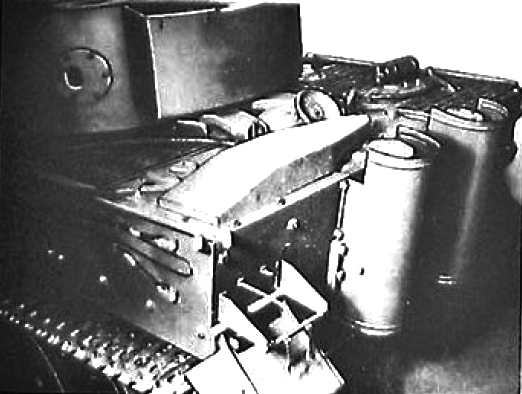
Panzer VI Ausf.H Tiger rear.
In the meantime, the Hauptauschuss Panzerwagen, or main production committee for armored vehicles production, raised the monthly production of Henschel from 10 to 15 by June and 30 in August, to be met by December. By January 1943 this was raised to 75 vehicles monthly (for September 1943), and a planned 125 for April 1944. But all these figures proved over-optimistic.
Eventually, the eight produced in August were sent near Leningrad with Heeresgruppe Nord. They first saw action on September, 16, showing teething problems with their transmission. New parts had to be manufactured and sent for replacement, which further extended the production delays. However, by December, all these problems were solved, and by early 1943, the monthly delivery rate was reached, with 35 in January, 32 in February, 41 in March, 46 in April, 50 in May, 60 in June, 65 in July, 60 in August, and peaked to 85 in September.
But, due to shortage of parts (caused by Allied bombings), this figure fell to just 50 in October, then 60 and 63 until the end of the year. With a completely overhauled supply chain, the production rate skyrocketed to 93 in January 1944, meeting the monthly goals for the first time in months, then 95, 96, 104 and 100 until May. The orders were reduced by the summer, as the new Tiger II production was set in. The last month of production was August 1944, and saw just 6 Tigers leaving the factory. During these two years, many modifications were applied. It must be said also that sabotage cases were signaled in November 1943, when steel shavings up to 12 cm (4.72 in) long were found in the idler wheel mounts of ten Tigers, leading to an inquiry.
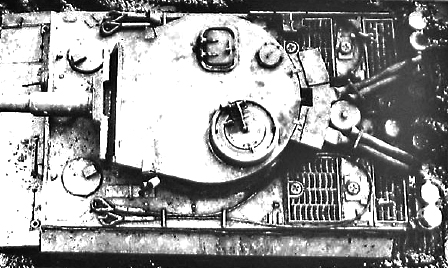
Tiger Ausf.H1, above deck view.
Maybach of Friedschafen did not keep clear separated records for its HL 210 and 230 engines. 153 were built in 1942 and 4346 in 1943 altogether. However, after a peak from January to April 1944 with 1794 engines, the factory was heavily bombed in several raids and production virtually stopped until October. Speer had the production reorganized and the engine was supplied nevertheless by Auto Union, Chemnitz at Sigmar-werk, with an additional 4366 HL 230 for the Tiger and Panther until 1945.
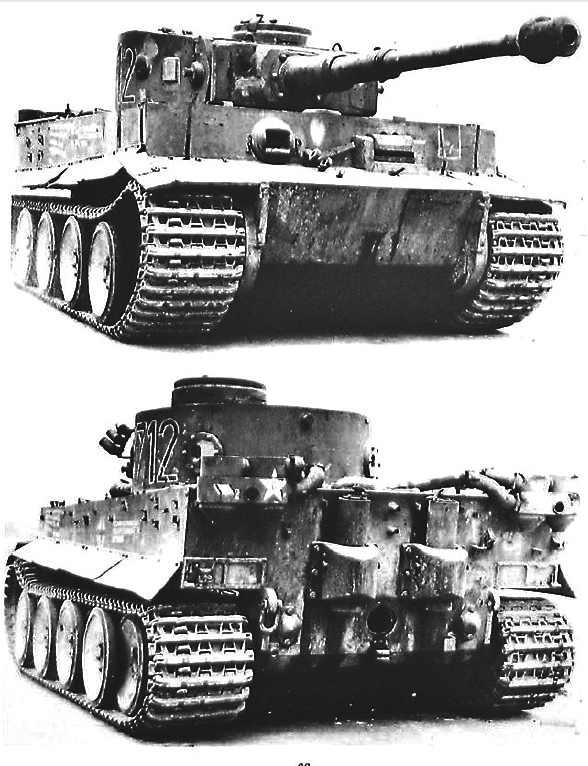
Panzer VI Ausf.H1
Transmissions were built by Adlerwerke, Frankfurt am main, as the Olvar 40 12 16 Getriebe and had 1850 delivered from 1942 to 1945. At the same time, Waldwerke Passau (Zahnradfabrik Friedschafen AG) also started production of this transmission in early to September 1944 (statistics unknown). The steering gears were produced by Henschel & Sons at Kassel, which was the inventor and held the licence of the Lenkgetriebe L600C. The main gun KwK 36 L/56 8.8 cm (3.46 in) was produced by DHHV and Wolf Buchau. Altogether, they delivered 1514 guns, all tested and approved by Heereswaffenamt inspectors from April 1942 to July 1944. The telescopic sights were supplied by Ernst Leitz GmBh, Weltzar, sole producer of the binocular TZF.9b and later TZF.9c.
By 1943, this concerned improvements of the cooling circuit by installing better hose clamps, longer operating rod for the inertia starter, fitting of the Argus lengkapparat to replace Henschel's Hosilit steering wheel, but also changed brake mounting and linking to increase spring tension, asbestos covered oil lines for the cooling fans, strengthened main steering shaft, gasket introduced between the exhaust pipe and muffler, fuel filter, wider rubber seal, improvements in the Olvar transmission, replacement of the retaining pin of the drive wheel, of the felt ring with two labyrinth ring seals to prevent oil leakage in the final drive and improved lubrication in January 1944.
By 1944, the pace of modifications accelerated and concerned three added grease fittings for the idler wheels arms, increased filler pipe diameter, additional overflow pipes on both sides of the engine cooling fan drives, additional springs in the clutch foot pedal linkage, relocated engine coolant temperature regulator and, eventually, modifications in the fire extinguisher and central drive gear (from beveled to straight teeth).
Modifications also concerned the hatch periscopes (protective armor hoods added in the spring of 1942) and new track guards added in November-December 1942, as well as other detail changes in January and May 1943. Mounts and fasteners for external tooling appeared in April-May 1943, and hanged continuously during production.
These concerned the deck horn (right of the driver's hatch), welding fasteners for the cleaning rods, tubes to store the engine hand-crank starter guide, storage tube for the spare antenna rod, steel cables (several types), other fasteners for various tooling equipment, new convoy light, new tow cable location, new long handled shovel location, modified U-shaped tow shackles, new track tool stowage box, modified left brackets for three cleaning rods, C-hooks on the left hull rear and deck, sturdier 20-ton jack mounting, among others. Many other modifications were also applied early on for submerged fording.
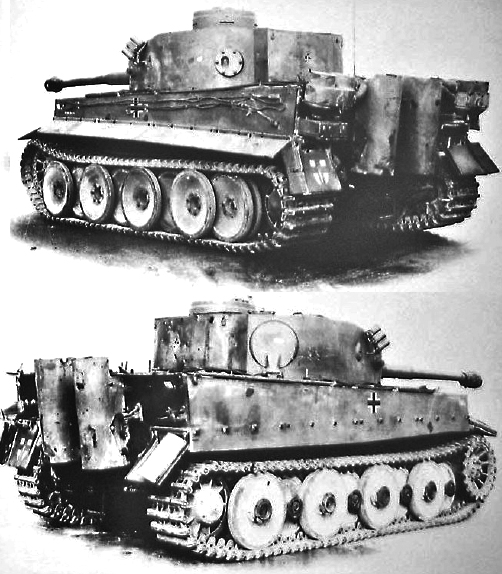
Ausf.H1 in Russia, early 1943.
The drive sprockets were first realigned in August 1942, then the hub was machined flat (Jan 1943) and additional double-locking strips were added in June 1944. On the rear deck, modifications occurred because the armor louvers over the cooling fans were too restrictive at first, and because of fording modifications. Many detail modifications were started in August 1942 and were continued until May 1944.
Other external modifications included a surprising and little-known rear tubular frame mounting in order to put a special canvas, making the Tiger resemble a large freight truck, in December 1942. "Winterization" or Wintermassnahmen, were a set of modifications started at the same time in Russia, including a new fluid spray injector, heater coolant transfer, crew compartment heater, and a blow torch coolant heater connected to the engine coolant circuit.
Some changes also occurred with an extra radio antennae (additional upper right corner mounting on the rear deck), strengthened and rubberized radio encasing and spring-mounted vacuum tubes for the intercom. For the engine, Feifel air cleaners were also mounted. The HL 230 P45 had a new, more efficient piston design, and the governor, preset to 2500 rpm, was reduced. The new engine fittings had improved bearings, often faulty. The shock absorber mountings were modified, as well as the fuel tank mountings.
Headlights were fitted with blackout driving slits, were reduced from two (mounted on the front deck) to just one, left of the driver hatch. The crew/engine compartment firewall was redesigned, an electrical heater for the batteries and a switch box was added, as well as a rubber protective sleeve to the battery cable. But the biggest external change on the chassis occurred with the replacement of the rubberized wheels with Gummigeferten Stahlauffrollen (rubber-cushioned steel-tired roadwheels), more simply known as "metal wheels".
Since rubber was harder to obtain, the roadwheel design was changed and soft steel bands replaced the original rubber. This was started in February and the crew could make the change themselves on the field. The bolts holding the hub caps were of increased size. Other modifications concerned the idler wheels in February 1944, wooden decking on top of the upper fuel tanks, and recycled hulls (a set of modifications tailored for the last batch of Tigers in June 1944).
Concerning the turret and armament, an impressive list of modifications started as soon as the first Krupp turret was delivered in April 1942, too long to enumerate there. These could be summarized as concerning the smoke candle dischargers, turret traverse lock, baggage bin (relocated from the side to the turret rear), spring counterbalance and cable pull for the hatch lids, rain shield, emergency firing, reinforced gun mantlet, emergency escape hatch, adjustable commander seat, internal stowage arrangement, S-mine dischargers, hydraulic turret traverse and retaining bolts, back flash shield, loader's periscope, turret's track holders, internal travel lock, turret MG mount, and an overall new turret design launched in July 1943.
This included its most recognizable feature, a brand new Prismenspiegelkuppel (commander cupola fitted with periscopes and a new AA ring), but also a new smaller pistol port plug, new relocated loader periscope, modified loader hatch, redesigned armor plate and, later, 40 mm (1.57 in) roof plates. Other changes included the close-defense weapon (roof, left rear) firing explosive shells, smoke candles, flares or orange smoke signals, new monocular gun sight, lighter muzzle brake, sockets for jib boom, recycled turret armor and poison gas detection panels.
In some cases, the paint was partly washed by the crew to form improvised two-tone camouflage, white and grey, or later white on sand, in straight lines or vermicels and degraded spots. However, the Tigers (T), for "Tropen", modified for service in Tunisia and southern Russia, were painted in a uniform sprayed two-tone Braun (RAL 2080) and Grau (RAL 7027). These concerned the SS units Grossdeutschland, SS-LAH, Das Reich and Totenkorpf, from December 1942 to February 1943.
By February 1943, a new scheme was introduced, with a uniform coat of Dunkelgelb (sand, RAL 7028), completed in the field by various camouflage schemes with blended sprayed vermicels applied by the crew in two colors, Deckpasten in Olivegruen (RAL 6003) and Rotbraun (RAL 8017). By August 1943, yet another modification occurred. Zimmerit anti-magnetic coating was factory-applied, then once dried, covered with Dunkelgelb. Then the same two-tone patterns were applied in the field by the crews. The gun was covered with a lacquer, but on the same tone as the rest of the tank.
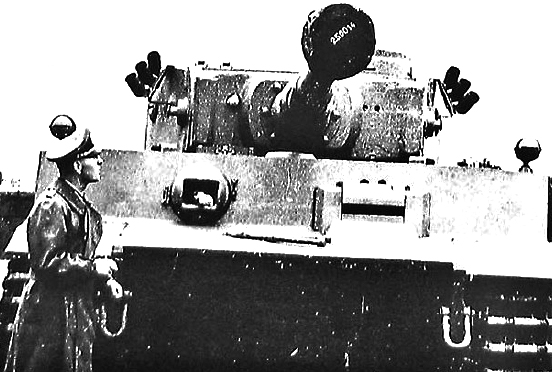
Tiger Ausf.H1 in Russia, fall 1942.
Namely, these were the Panzerdivision Grossdeutschland (Heeres), the 1st SS Leibstandarte Adolf Hitler (LSS-AH), 2nd SS Das Reich and 3rd SS Totenkopf (Panzergrenadiers), which all fought at Kursk. But, if Grossdeutschland and Totenkorpf retained their companies unscathed, the 1st and 2nd SS Panzerdivisions had to give their units to form the 101st SS Tiger Battalion, part of 1st SS Panzer Corps after Kursk. This was later superseded by the 102nd and 103rd Waffen-SS heavy tank battalions. Outside Grossdeutschland, Heeres Heavy Panzer battalions comprised the 501st, 502nd, 503rd, 504th, 505th, 506th, 507th, 508th, 509th, 510th, 511th and the 301st (radio control) units.
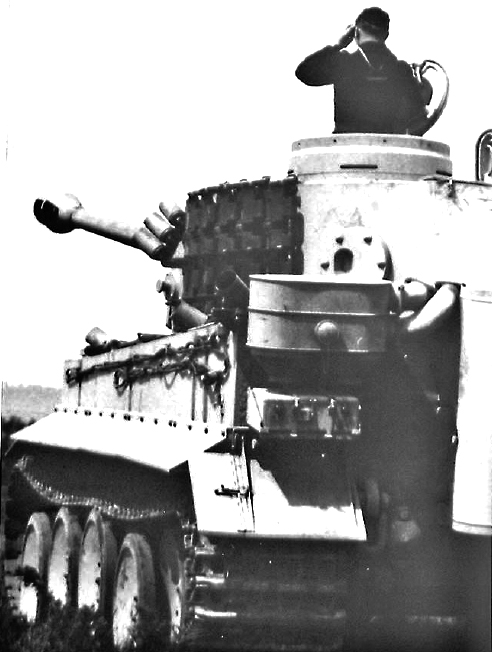
Some units were especially successful, like the 13th company, SS-Panzerdivision GrossDeutschland, and the s.SS Abt. 103 and 502. On one occasion, at Kursk on July, 7, 1943, a single Tiger, commanded by SS-Oberscharführer Franz Staudegger (2nd Platoon, 13th Company, 1st SS-LSAH), engaged about 50 T-34s around Psyolknee (south of Kursk salient), used all his ammunition and claimed 22 Soviet tanks, making the rest retreat. He was awarded the Knight's Cross, and was followed by several other "aces" during the war, especially in Normandy. It was not unusual that a tank commander became an ace after his first engagement (an "ace", like for the Luftwaffe, had to claim ten tanks, which was easier to prove because of the more geographically limited battlefield).
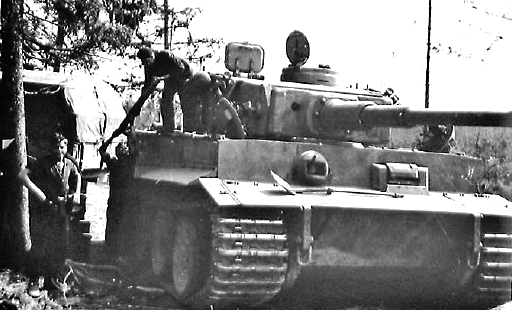
Early Ausf.E in Russia, May 1943.
They proved highly valuable against the US 1st Armored Division, but took heavy losses in March 1943, with only one Tiger left. Although reinforced by eleven other Tigers afterwards, the 501st was later transferred to the newly-arrived 504 s.Pz.Abt on March, 17, 1943. By April, this unit was separated between the 8th Panzer Regiment and Hermann Göring Division. At the time of the battle of Tunis, there were six Tigers attached to the 5th Panzerarmee, and seven to the remnants of the Afrikakorps. Only four survived the battle, but the battalion claimed more than 100 US and British tanks.
These were sabotaged and blown up to prevent their capture, but, previously, the British managed to capture a single Tiger in April 1943, number 131, on Djebel Djaffa hill. It was shipped back to Great Britain and was thoroughly inspected, leading to some invaluable intelligence reports (some sent to Soviet intelligence prior to Kursk) and later improvements in AP rounds and AT guns. It is now displayed at Bovington, in original colors and running condition. All SPzAbt. 504 Tigers were destroyed or captured in North Africa and the remainder elements surrendered on 12 May 1943.
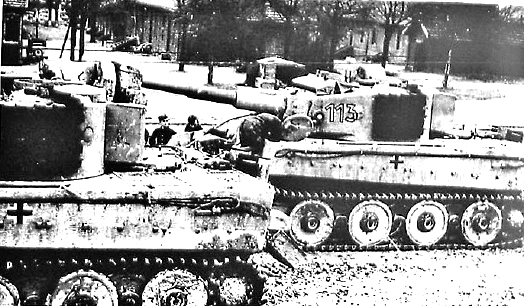
Tiger Ausf.E mittlerer produktion sPz.Abt. 501, October 1943.
However in April 1943, six Tigers were ordered by the OKH to be stationed in Sicily until transfer to Tunisia, and was to be attached to the Panzer-Abteilung 215 with a full platoon of six Tigers, also shipped to Sicily. So these were 17 Tigers in total, nine from 2nd company of the 504th, two replacements for the 501st, and the six issued for the 215th.
These Tigers were attached to Panzer Division Herrmann Göring. They attacked the American landing zone on 11 July 1943, however were scattered or damaged by naval gunfire, and without a support company, unable to be repaired. Within three days, 10 were destroyed to prevent capture, followed by six more later and just the last one was shipped back to Italy. (src www.fprado.com/armorsite/tigers-02.htm)
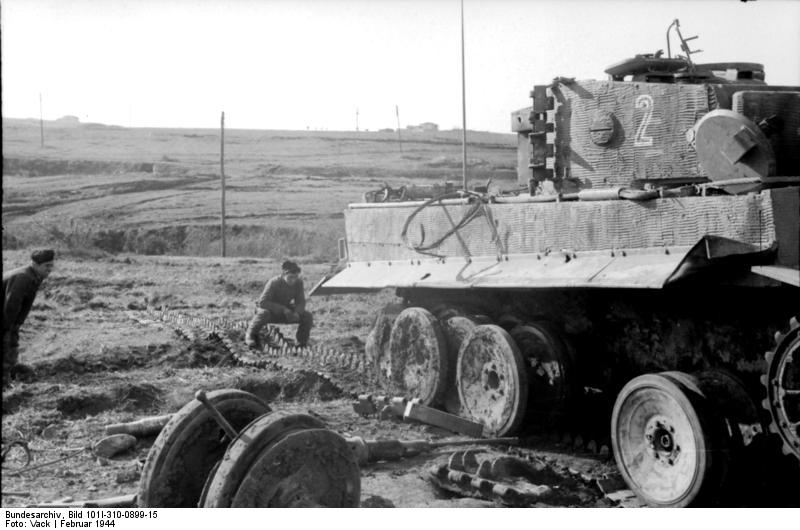
Italian Tiger from the SPz.Abt. 508 in repairs, en route to Anzio, a fate shared by 60% of the unit.
At first they were successful, only to be repulsed later by naval gunfire. Five replacement Tigers were sent on 23 March, followed by six in April 1944. Because of further losses in May and early June, the 508th received 27 replacement Tigers, but Hudel was dismissed in May and replaced by Hauptmann Stelter. On February 1945, the remaining 15 Tigers were attached to the 504th Abt. and shipped back to Germany.
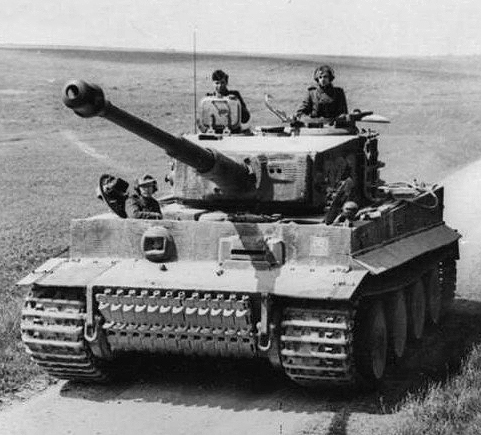
Northern France 1944 - Credits: Bunderarchiv.
The other unit present there was the s. SS-Pz.Abt. 101, part of the LSSAH, and s.SS-Pz.Abt. 102. It was here that the kill ratio of the Tigers caused most turmoil, to the point of delegating inquiries, and leading to new tactics. The SS Pz.Abt. 102 claimed about 300 vehicles, including 227 Allied tanks. Michael Wittman, the "black baron", already a veteran of the Russian front (117 kills), claimed by himself 138 tanks and 132 AT guns, plus perhaps a hundred and more armored vehicles and trucks of all types. His most famous action occurred at Villers-Bocage, destroying an entire column of the British 7th Armored Division in 15 minutes (14 tanks, 15 APCs, 2 AT guns). Other famous tank commanders that became aces decorated with the knight cross were Johannes Bölter, Ernst Barkmann, Otto Carius and Kurt Knispel. The latter was Germany's top ace claiming 168 tank kills. His fighter ace equivalent was Erich "bubi" Hartmann, with 352 kills.
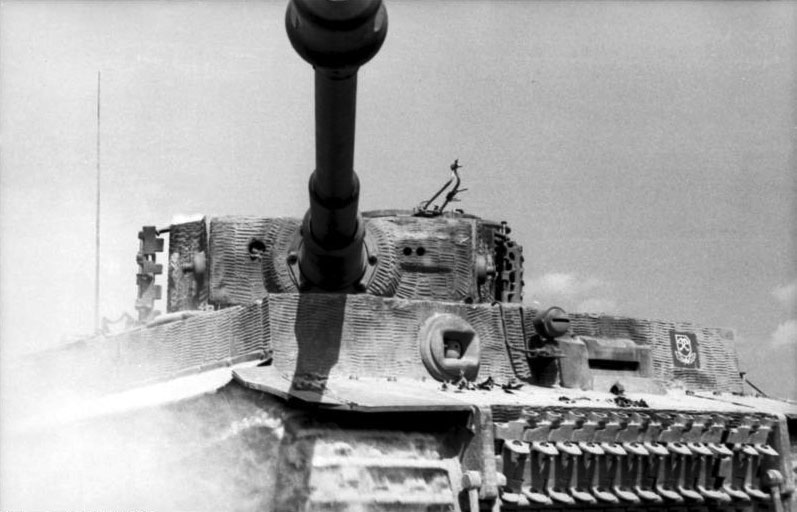
Late Tiger type Ausf. E, France 1944 - Credits: Bunderarchiv.
The Allied response tactic came as mobility. When a Tiger was spotted, and when the terrain line of sight was blocked by hedgerows, Sherman units usually tried to outflank the Tiger. The great chance of the Sherman was its superior mobility and speed, and in return the slow-moving turret of the Tiger. But despite these assets, losses were high. For every Tiger destroyed, an average five or six Sherman would pay the highest price. On a large open-field terrain with at least two miles of visibility, a well-camouflaged Tiger could destroy entire platoons before they came in range.
The 502nd fought to defend Budapest (September 1944) and later at Debrecen (November). The unit was almost destroyed when acting in support of the 60th Panzergrenadier Division Feldherrnhalle, and later the remnants were fully integrated as the sPz.Abt. FHH. The 509th was also engaged in this sector, to relieve Budapest (Operation Konrad III) in January 1945, but failed. It took heavy losses, 40 of its 45 Tigers were reported missing in February, but the unit claimed 203 enemy tanks, 145 guns and 5 aircraft for only ten losses in January. It later took part in the battle of Vienna with the IIIrd Panzerkorps (Operation Frühlingserwachen).
The 501st defended a large sector, well forward during the Vistula–Oder Offensive in January 1945, and took quite heavy losses, so much so that in February the remnants were incorporated into the 512th and fought at Paderborn. The 502nd counted aces like Otto Carius and Johannes Bölter and claimed, by May 1945, to have destroyed 1,400 enemy tanks and 2,000 guns. The 502nd was renamed 511 in January 1945, and was equipped with a mix of Tiger Is, IIs and Hetzers. The battalion was disbanded after heavy losses on April, 27, on the eastern front. Remaining personnel of the 508th (Italy) were reformed as a small Kampfgruppe of one Tiger and six Panthers in March, also fought at Paderborn, Scherfelde, Hofgeismar, Polle, and Berlin. The 510th (group north) took part in the fighting retreat in eastern Prussia and Kurland from October 1944 to January 1945.
The overall cost of a Tiger was more than that of four StuG IIIs. There were great expectations that its kill ratio could compensate for the massive combined production of the Allies, but even these 10:1 figures (only reached by three Abteilungs) proved insufficient to stem the enemy offensives.
The Tiger on Wikipedia
Tiger-center, one of the most exhaustive websites on the subject
And about 50 more.
An article By David Bocquelet, first published in December 2013
Excellence versus numbers
When comparing the small number of Panzerkampfwagen VI Ausf.E (Sd Kfz 181) Tiger Tanks produced (only 1346), to the more than 120,000 T-34s and Shermans combined, one can appreciate the psychological impact of this model, at least from the Allied tank crew perspective. In its concept laid the very core of the German conception of a heavy tank. Something which targeted absolute excellence in design, combining lethality with the best possible protection, only given to elite crews, all this regardless of the cost. Excellent engineering and training versus numbers underlined all this philosophy and was reflected, later, in small tactical unit operations.
The Tiger was a formidable machine that pushed the boundaries of armored warfare and forced the Allies to devise better tanks. It powerfully symbolized all the might of the Nazi war machine, as dreamed off by Hitler, and later turned through propaganda into a "Wunderwaffe" (wonder weapon) in a mostly defensive war. The Tiger, like all new tanks, had teething problems at first and it was never an easy tank to maintain, but it was always deadly effective (with a 10:1 up to 19:1 kill ratio), earning a capital of fear that was unrivaled during the war.
Allied crews found themselves hopeless with their inadequate machines, having to improvise costly tactics to deal with it. The Tiger gave fame to a few WWII tank aces, like Michael Wittman, something rarely heard of before, since the life expectancy of a tank crew was always quite shorter than that of fighter pilots.
A long development history, started in 1935
The search for a suitable engine
The first mention of a 30-ton Panzer can be found in the note written by General Liese, head of the Heeres Waffenamt, on 30 October 1935. This was the result of the weight estimation for a tank equipped with a high velocity 75 mm (2.95 in) gun, powerful enough to destroy the Char 2C and B1 French tanks, and a minimum 30 mm (1.18 in) of armor. The representative of the Wa Pruef 6 in charge of the project met with Dr. Maybach in October, to discuss the feasibility of a 600/700 hp engine.Maybach dismissed a 16-cylinder as too long to fit in an engine compartment, so only a scaled-up 12-cylinder could be conceived, although it required a tremendous amount of development to reach the targeted output of 600 hp. Later, discussions led to the conclusion that only a 16-cylinder could provide the 700 hp needed for a 30-40 ton tank. This was still optimistic, given the fact that in 1936 Maybach was still struggling to produce its first compact 300 hp engine.
Wa Pruef 6 also studied the use of an aircraft engine, characterized by high-torque and low rpm, but this posed the obligation of redesigning many components of the drive train, which would mean sacrificing other vital aspects to stay within the 30 tons limit.

Preliminary prototypes ordered by Wa Pruef 6
In January 1937, Baurat Kniepkamp from Wa Pruef 6, the department which laid the specifications and contacted the contractors, ordered a chassis (Fahrgestell) from Henschel, and the turret by Krupp, already contacted to study a 30-ton tank turret housing a 75 mm (2.95 in) gun in November 1936. The first designation was BW (verstaerkt), for Begleitswagen (escort tank, heavier), to differentiate this model from the Panzer IV forerunner, also called "BW". In March 1937 this was changed to IW, for "Infanteriewagen", then DW ("Durchbruchswagen" or breakthrough tank), and in November 1939, VK 30.01 alte konstruktion (DW).The Durchbruchswagen DW 1 and DW 2
According to the delivery plan from the 1st of October 1937, Henschel had to provide a DW fahrgestell prototype with Cleveland track system gear ("Clectracgetriebe"), and one with differential drive ("Uberlagerungsgestriebe"), in the second half of 1938, for trials. They were both renamed, by Henschel, to DW 1 and DW 2 Erprobungst-Fahgestell (experimental chassis). The DW 1 was made of soft steel with plate thickness of 50 mm (1.97 in) on the front, side and rear, and 20 mm (0.79 in) elsewhere.It was propelled by a Maybach 120 TR, with varlorex transmission and cletract system of three-stage steering gears allowing a maximum speed of 35 km/h (22 mph). There were also six double road wheels per side, suspended by torsion arms. The track was center guided, with a 300 mm (11.8 in) pitch. The DW 2 was similar but with automotive improvements made to the steering gear, final drive, parking brakes, torsion bars, and having the tracks decreased to a 260 mm (10.2 in) pitch and changed drive sprockets. Both weighed 30 metric tons and were capable of 35 km/h (22 mph).

On the Krupp side, a conceptual preliminary design for a turret (AF30304) was sent on 22 February 1937. Dr. Olbricht from Wa Pruef 6 informed Krupp of various points for the definitive design in March 1937, notably the 1500 mm (4.92 ft) turret ring, 50 mm (1.96 in) thick turret walls, plus 20 mm (0.79 in) mantlet, new ball bearing, and adapted elevating mechanism, but no electric traverse.
A prototype had to be produced directly, bypassing a wooden mock-up stage. Finally, on 24 June 1938, Wa Pruef 6 awarded Krupp a contract for a trial turret. In April 1939, modifications were requested and a schedule required the completion of the turret until May, 26, 1939, which had to be then shipped to Magdeburg, to be compared to that of a Panzer IV.
The VK 30.01
Alongside the WB initial tests in September 1938, the Heeres Waffenamt authorized the development of a 30-ton tank prototype called VK 30.01. This was discussed with Wa Pruef 6 in January 1939, with specifications including a 75 mm (2.95 in) KwK L/24 gun (short barrel), the same crew as the Panzer IV and 50 mm (1.97 in) of armor.Henschel devised a new chassis for this purpose, with all the lessons retained from the DWs. It featured a new Maybach HL 116 engine, new drivetrain and, most importantly, seven pairs of interleaved wheels (Geschachelte), meant to distribute the 32 tons of the tank and to reduce the ground pressure.
At the same time Krupp was awarded the construction of an armored test hull, to be delivered at Kummersdorf on 23 April 1940. The new construction involved dropping the vertical joint assembly, for new PP792 armor plates. However, this hull was not delivered until September 1940, and tests involved only 37 mm (1.46 in) guns.Meanwhile, Maybach made available the new HL 190 and HL 150 (400 hp) engines, and well as new transmissions. Krupp designed a turret to match the VK 65.01, for better commonality, having a low profile, as the gun centerline was to be 335 mm (13.2 in) over the deck. Externally, it had many features identical to the Panzer IV turm. As requested, there was also a small oval hole for a rearward machine-gun, with an armored semi-disc which pivoted to close this weak point. A turret observation periscope was also to be provided.

On November, 19, 1939, it was agreed that Henschel would deliver three prototypes of the neu konstruktion armored chassis, from March to April 1940. In July 1940, Krupp was ordered to deliver a complete turret with the PP 739 armor plate. Later, eight armored hulls were contracted from Henschel, the last scheduled in October 1941, but in reality delivered on 30 November.
On 25 September 1942, Oberstleutnant Krekel from the Wa Pruef 6 ordered four new updated chassis to be used for driver training. Already, by November 1941, there were concerns about upgrading the main gun (following the encounters with the first KV-1s) to the long-barrel L/34, then the L/43. Krupp objected that this would have triggered further delays. Eventually, this prospect was dropped on January, 30, 1942. The eight VK 30.01 turrets would eventually be placed on the Atlantic wall from May to September 1944.
The VK 36.01
This short-lived projected was born in June 1939, when Krupp was asked to develop a 105 mm (4.13 in) armed turret. The turret walls had to be 100 mm (3.94 in) thick and the gun was a standard L/20 or L/28 howitzer, all of which to be packed on a standard BW hull, with a top weight of no more than 30 tons. It was then designated AW (Artilleriewagen).By mid-1940, Henschel was ordered to modify the BW Fahrgestell to mount the new Krupp 105 turret. At the same time, it was revised internally to accept the new Maybach HL 174, giving a 450 hp max output. The hull front had to be 80 mm (3.15 in) thick and the total weight was uplifted to 36 tons, sitting on interleaved wheels.
Eventually, on the 26th May of 1942, Hitler intervened to specify that the new heavy tank should have the frontal armor 100 mm (3.94 in) thick, and 60 mm (2.36 in) sides, and ordered six prototypes from Porsche and Henschel. Following this, Wa Pruef 6 remade the specifications. The turret now needed to accept the 75 mm (2.95 in) Waffe 725 (without muzzle brake) and, on 11 June 1942, notified Krupp to drop the 105 mm (4.13 in) project and convert the turret according to the new specifications.
By August, this was renamed "Tigersprogramm". Eventually, the sole VK 36.01 chassis was delivered in March 1942 for tests, after being equipped at the Maybach factory near Friedschafen. The original six turrets ordered from Krupp were turned, in the meantime, into turmstellungen (fixed turrets), but completion of the required modifications was never carried out.

The Porsche Tiger
Porsche was asked to study the feasibility of heavy and even super-heavy tanks since 1941, and tried to respond in a innovative manner to the challenge posed by the ultra-sturdy transmission needed for the task of transferring such loads. The most original feature of its designs were electric motors powered by connected gasoline engines and external suspension torsion bars to save internal space.The Porsche Type 100
Porsche's first prototype for a heavy tank was launched in late 1939. The Typ 100 was -with Wa Pruef 6 support- the fruit of the collaboration of Krupp (armored hull), Steyr (air-cooled engines) and Siemens (electrical components). Nibelungenwerke performed the final assembly. The drivetrain was powered by twin ten-cylinder engines, each connected to an electrical generator. These animated two electrical motors at the front, powering the drive sprockets. There were three sets of roadwheels mated on a single external longitudinally-mounted torsion bar.The tracks were supported by two double return rollers on each side. Porsche was awarded with a contract for three armored hulls and a soft-steel one, which was only completed in July 1941. As early as March 1941, Krupp engaged itself to deliver six turrets equipped with the new 8.8 cm (3.46 in) KwK L/56. The unique Typ 100 chassis undergone thorough trials at Nibelungenwerke, and the program, then known as Leopard, changed its name into the Tiger.
The VK 45.01 (P)
The tank had to be larger and Porsche made a series of modifications to the Typ 100, with new engines, relocated drive sprockets to the rear, increased frontal armor to 100 mm (3.94 in), new engine compartment and more fuel storage, 60 cm (23.6 in) wide tracks and metal-rimmed road wheels.The return rollers were dropped. The Porsche new heavy tank prototype was then designated VK 45.01 (P). In July 1941, Krupp was ordered to deliver a hundred hulls derived from the new prototype and the same number of turrets to be assembled at Nibelungenwerke. In turn, the company was ordered to deliver ten complete pre-series vehicles for tests by May 1942.
But the completion was later rushed to match Hitler's birthday in April. However, serious supply problems with automotive parts delayed the completion of the first unti; July 1942, then the nine others followed in small batches until October, when the official objective was the completion of 76 Tiger(P)s.

These delays were cut short by Hitler's decision to terminate the program, as the remaining 90 vehicles would be turned into Panzerjägers with the new 88 mm (3.46 in) L/72 gun. Later, these were known as the Sd.Kfz.182 Ferdinand/Elefant. The ten first VK 45.01 (P)s would see service with the test unit Schwere Panzer Abteilung Abt 503, and were known in short as the Tiger(P). Only one seems to have been used in action, a modified Panzer Befehlwagen (with a new set of long-range radios) in Ukraine, with Abteilung 653, from April to July 1944. Three other hulls were completed as Bergepanzer Tiger(P), and three others as Rammtigers. Eventually, four of these hulls will receive definitive turrets made by Krupp and were kept for tests in August 1943.

Japanese officers testing the Panzer VI Ausf.H1.
Panzerkampfwagen Tiger final design
Upgraded specifications
The final Tiger was, consequently, a mix of the parts from previous prototypes by Henschel and Porsche. The turret and gun were retained from Krupp AG Essen's design meant for the VK 36.01, but the chassis, engine, transmission and many components were from Henschel's VK 45.01(H) final design, which was developed after a decision meeting at Berghof on May, 26, 1941.It was then decided that necessary numbers of the 7.5 cm (2.95 in) Waffe 0725 tapered-bore needed to be stockpiled, but the adaptation of the new 8.8 cm (3.46 in) KwK needed to be investigated.
The final armor thickness was fixed at 100 mm (3.94 in) frontal and 60 mm (2.36 in) sides and rear. However, in September 1941, the head of Wa Pruef 6, Oberst Fichtner, specified that the initial tapered-bore gun should be dropped and the lowered Porsche turret used instead, with the 8.8 cm (3.46 in) KwK, because of the tight schedule. The Henschel project was upgraded to a 45-ton program, and the cooling system and larger radiators had to be studied.
Hull
An enlarged body with side panniers over the tracks was to provide additional room for the engine compartment, as well as extra space for ammunition stowage and other equipment. Angled iron beams had to be welded to both of the panniers and hull. During the development stage of the new chassis, Dr. Engineer Aders noted that the new requirements complicated work on the hull, as a fording depth of 4.5 m (14.7 ft) was envisioned, and many components had to be redesigned. Armor shields, which could be lowered, were added on each side to protect the tracks.The side armor was increased to 80 mm (3.15 in), and extra rubber roadwheels were required to match the specified ground pressure for this 55-ton tank. The tracks had to be extended to 725 mm (2.38 ft), and pitch to 130 mm (5.11 in).
Engine
The latest Maybach HL 210, rated for 650 hp, was envisioned for production. Cooling had to be completely redesigned, and new auxiliary fan drives were added. The engine compartment had to be totally sealed. Air ducts were connected to extraction pipes on the rear of the vehicle, which was ornated by two massive exhaust noise mufflers.Other modifications included the side drive shafts, final drive, brakes, return rollers (abandoned), roadwheel arms, torsion bars, disc roadwheels, rubber tires, shock absorbers, bump stops, idler axes, and idler wheels, borrowed or copied and adapted from previous designs.
Four fuel tanks served the engine, with a total of 348 liters inside the two upper tanks (inside the side compartments, above the engine), and 186 liters in the two lower fuel tanks, on each side of the engine. An extra 8 mm (0.3 in) thick armor plate protected the upper tanks from any shell fragments/small caliber rounds which could penetrate the armor grill above them, bolted to the deck. These were protected by an extra wire mesh screen to prevent any dropping of an explosive charge by infantrymen.
This armor grill served as an air intake, to cool the air flowing through the radiators, located directly behind the fuel tanks, each actioned by two fans. The fan drive housing is connected to the engine compartment wall and watertight sealed. The fan area was protected by a heavy armor grill, through which the cooling air is exhausted. A wire mesh protection was bolted above to deflect any grenade. The transmission is cooled by a fan built into the firewall, between the fighting and engine compartments. The cooling air is pulled through a duct running along the hull floor and blown into the jackets surrounding the engine exhaust headers.
Electrical system
The electrical system consisted of an ignition and lighting system. A twin polar main battery switch, built into the firewall, divided the entire system from the source of current, two 12 volt batteries, controlled by a regulator and charged by a generator when the engine is running. Lighting consisted of the radio operator panel lights, two dismountable headlights, one waterproof tail light, and the turret lighting. The radio and intercom were connected to the the battery in such a way that the main power switch cut out the positive line. Four suppressors were installed to prevent radio interference and the wires were double insulated.There was also a fire extinguisher system installed in the engine compartment, directed against the carburetor and fuel pumps, fully automatic, and using the CB agent. Thermostats activated the system when detecting a 120°C surge, and the discharge valve was opened for seven seconds. If that was not sufficient, another one would follow and potentially three others, as permitted by the three liter capacity CB flask.
Stowage
Ammunition bins (located inside the hull side panniers) were protected by closing metal lids, for protection against sparks and fire. Sixty-four 88 mm (3.46 in) rounds were stored inside, half on each side, in two 16-rounds bins per side. Behind the driver there was an extra reserve of six rounds. All these bins were spacious enough to allow the storage of both HE or AP rounds. Sixteen of the latter were normally stored below the panniers, and six more held in reserve in a bin below the turret platform, accessible through a hatch in the turntable floor.External stowage composition and location changed continuously during production, but normally counted one tool box for track tools, a rear turret stowage bin for ten spare links and pins and a 1200x1800 mm (3.93x5.9 ft) tarp, a 15-ton steel jack with lifting housing, wooden block and fording crank, a centering guide and hand crank shaft for inertia starter, a 14 mm thick (0.5 in), 15 m long (49 feet) towing steel cable (or two 32 mm thick, 8 meters long), a 2-liter fire extinguisher, ax, shovel, spade, wire cutter, a 1.8 m long crowbar, a 6 kg sledge hammer, six cleaning rods and four tow shackles, plus a plate to cover the engine's air intake slit.
Fording equipment and procedures
A diving system was created from scratch, using data and experience gathered by previous experiments on the Panzer III. It was obvious that the new tank was off-limit for most bridges, so fording rivers was the only solution. The turret and hull roof were made watertight, all the air intakes sealed by rubber gaskets. On the rear deck, a three-piece pipe was installed, which could be connected and erected with a three-meter high schnorchel. Engine exhaust gas was blown underwater, and flooding prevented by a hinged cap.The fans were disconnected using the clutches. A procedure was applied before diving, to realign or close several butterfly valves in the exhaust cooling air, in order to deflect the flow to the schnorchel. Special heed was applied to the airtight seals on the fire wall, to avoid carbon monoxide gushing into the fighting compartment. A sump pump was also installed, to cope with any water leaking from inside the hull.
Turret
A new turret traverse drive was devised, electrical, but with a manual correction system. It comprised a ball clutch, sump pump drive, and high hydraulic pressure pump. All three could be disengaged independently. There were some trials of the intended 7.5 cm (2.95 in) KwK gun, which ultimately failed to achieve the intended penetration power at long range. The 8.8 cm (3.46 in) was eventually chosen instead, and penetration power bolstered by using new armor-piercing rounds.This turret was placed in the middle of the hull, and the tube, recoil cylinder and pneumatic recuperator were mounted in the gun carriage, which occupied a sizable portion of the interior. The gun had a MG 34 coaxial machine-gun, protected by a common mantlet. The gun could elevated by hand from -8 to 15 degrees of elevation. The forward weight of the gun and carriage was counterbalanced by a spring equilibrator. The spent casings were caught in a casing sack. Turret traverse was either hydraulically powered (auxiliary engine) or by hand. The Turmzielfernrhor TZF 9b binocular gun sight was fitted with a 12 hour azimuth indicator system, helping the commander to designate targets to the gunner.
The 100 mm (3.94 in) thick turret front plates were angled at 5° from the vertical, but the 80 mm (3.15 in) bent side plates were flat, taking the shape of a horseshoe, with the front closed by the upper and lower front plates. The leading edge of the turret roof was a 40 mm (1.57 in) thick plate, extending the turret width behind the upper front plate. The cast mantlet thickness was ranging from to 85 to 200 mm (3.35-7.87 in) depending of the angle. There were two vision slits on each forward turret side and two MP-klappen pistol ports on the rear sides. The cupola was mounted on the roof's left side and the ventilation fan to the rear.
The turret had three lifting studs for removal operations. The turret's support ring rested on the hull turret ball-bearing race, 2100 mm (6.89 ft) in diameter, comprising two grooved steel rings housing seventy-nine 40 mm (1.57 in) supporting ball bearings and the same number of 39 mm (1.56 in) spacing ball bearing. The gear ring was bolted to the armor hull and comprised 240 teeth selves for manual traverse drive. An inflatable rubber inner tube served to watertight seal the gap (when inflated), while water seeping into the ball bearing race was drained out by a tube sealed with a threaded cap. There was also a sealing ring, protecting from sand and mud.
The loader was on the right side, as the elevation mechanism, and the seat rested on the bridge. The gunner azimuth was mounted on his front left, on the turret ring, and served by a traverse mechanism. Both gunner and commander seats rested on the left of the bridge. The hydraulic drive controls were mounted to the left of the turret platform, connected by a drive shaft to the traverse mechanism of the turret ring. The turret platform was suspended by three massive supports fastened to the ring, gear housing and gun bridge support. The hull was accessible from below through a hinged hatch built in the platform floor.
Transmission
The Maybach Olvar 40 12 16 transmission was aided by hydraulic shifting after pre-selecting the gear. The L-600 C steering gear designed by Henschel had three radii, later reduced to two, after a weak point was discovered. Shifting was performed by lined clutches and hydraulic pressure. In case these failed, the backup were the steering brakes. The vehicle could turn on the spot when disengaging the steering gear.Suspension
The schachtellaufwerk, or interleaved suspension system, was needed due to the weight of the tank and the need to evenly distribute it. This was a complex system, with eight torsion arms on each side, leading on the left side and trailing on the right side. Each torsion arm was attached to a torsion bar, mounted transversely across the bottom of the hull. Three roadwheels were attached to each torsion arm. The outer one was connected by a bolted flenge, so that it could be removed to reduce the overall vehicle width for loading on the railcar. When travelling, the up-and-down motion of the arms is dampened by the torsion arm hydraulic shock absorbers. These were attached to four (two front, two rear) torsion arms, with their movement limited by rubber stops.Tracks
The tracks of the Tiger were so large that transport by rail was not possible. So, two types of tracks were created, the Marchkette (operational) Glesketten, fitted near to the operation area, and the transport ones (Verladekette), quite narrower (520-725 mm/20.47-28.54 in). The change of tracks also imposed the removal of the outer roadwheels. The normal tracks allowed the lowering of the ground pressure to just 1.11 kg/cm2, and was made of 96 unlubricated soft steel links. The Verladekette had a 1.545 kg/cm2 ground pressure.Other equipment
Outside the TZF9b binocular sight, there was a KZF2 gun sight for the machine-gun ball mount, a KFF2 driver periscope with one protective glass block 70x270x94 mm thick, for the driver's visor and two spare, and eleven smaller ones (150 mm wide) for the vision slits (2), commander's cupola (5), and 4 spare. The two MG 34s (hull and turret) had armor sleeves ("panzermantle"). There were also thirty-two gurtsacks bags for the ammunition belts, one MP-38 pistol for self-defense, a signal pistol with 24 signal flares, one gyroscopic compass, and one out-of-action signal flag.Radio equipment comprised two sets for external communications, an ultra-short 10-watt FU-5 emitter (5-10 km/3.1-6.2 mi range) for tank-to-tank communications, coupled with a FU-2 receiver, but nine out of 15 tanks in each company of Tigers had only a FU-5. An intercom system was fitted, and four members of the crew had headsets with microphones. The loader wasn't equipped. Each company comprised a single modified Panzerbefehlswagen fitted with an extra equipment mounted in place of the turret machine-gun mount.
This comprised a FU-5/FU-8 (Sd.Kfz.267) and FU-5/FU-7 (Sd.Kfz.268). One of these was mounted in the hull, and both were suspended by rubber-cushion bands to the hull or turret. The latter one used a long-range telescopic pole which required storage space, so many equipment (including MG ammo) were dropped in order to make room. However, an AA mount was fitted around the commander cupola ring. There was a crew of five, two (including the loader and an extra) acting as radio operators, and the gunner as signalling officer.
Tiger prototypes and production setup
The Tiger project went through a series of denominations. It was designated Panzerkampfwagen VI H (for Henschel), with the ordnance inventory Sd.Kfz.182 in August 1942, Tiger I in October, then Pz.Kpfw.VI H1 or Tiger Ausf.H1 in December and, after some modifications, Pz.Kpfw. Tiger Ausf.E in March 1943. It's ordnance number was also changed to Sd.Kfz.181.The Ausf.H1 prototype completed in April 1942 had no turret basket, a horn on the superstructure roof, no periscopes on driver's and radio operator's hatches, no air intake on the engine hatch, a hull mounted wire antenna and the cupola hatch lid open to lay flat. The protruding tracks were not side-protected, but the front tracks were protected by long and large mudguards which were not kept for pre-production.
The first "marriage" of the Porsche turret on the Fgst.Nr.V1 chassis was performed on April, 11, 1942, and summary tests were performed at Kummersdorf until the prototype was examined four days later. The demonstration before Hitler himself, at his headquarters, was performed on April, 20, and was considered successful, although some problems occurred with the cooling system and brakes.
The second VK 45.01 prototype was delivered at Kummersdorf without turret, but equipped with a modified HL 210 engine on May, 17, to perform a 25 km (15.5 mi) test track trial. On May, 23, Krupp's second turret arrived as ordered and was mounted it. However, the second trial phase showed that the prototype was plagued with automotive problems. In June, the problems were still delaying the production.

Panzer VI Ausf.H Tiger rear.
Tiger production
The new schedule for deliveries by Henschel was set for June (two), July (thirteen), and August (ten). Albert Speer, heading the Tiger program, was informed that the brake problems needed to be solved first. Later on, in July, Henschel signaled other problems with the transmission, final drive, steering, gear, in addition to the brakes, but, at the same time, estimated a total delivery of 144 pre-series vehicles for April 1943. The vehicles were named in these official documents "Geraet C10" by the factory.In the meantime, the Hauptauschuss Panzerwagen, or main production committee for armored vehicles production, raised the monthly production of Henschel from 10 to 15 by June and 30 in August, to be met by December. By January 1943 this was raised to 75 vehicles monthly (for September 1943), and a planned 125 for April 1944. But all these figures proved over-optimistic.
Eventually, the eight produced in August were sent near Leningrad with Heeresgruppe Nord. They first saw action on September, 16, showing teething problems with their transmission. New parts had to be manufactured and sent for replacement, which further extended the production delays. However, by December, all these problems were solved, and by early 1943, the monthly delivery rate was reached, with 35 in January, 32 in February, 41 in March, 46 in April, 50 in May, 60 in June, 65 in July, 60 in August, and peaked to 85 in September.
But, due to shortage of parts (caused by Allied bombings), this figure fell to just 50 in October, then 60 and 63 until the end of the year. With a completely overhauled supply chain, the production rate skyrocketed to 93 in January 1944, meeting the monthly goals for the first time in months, then 95, 96, 104 and 100 until May. The orders were reduced by the summer, as the new Tiger II production was set in. The last month of production was August 1944, and saw just 6 Tigers leaving the factory. During these two years, many modifications were applied. It must be said also that sabotage cases were signaled in November 1943, when steel shavings up to 12 cm (4.72 in) long were found in the idler wheel mounts of ten Tigers, leading to an inquiry.

Tiger Ausf.H1, above deck view.
Suppliers
Production of the chassis and final assembly was performed by Henschel, and armor components by Fried.Krupp AG Essen. From the beginning, Wegmann was charged with the fittings and final assembly of the turrets produced by Krupp, like the hydraulic traverse systems. By June 1944, Krupp had assembled no less than 537 armored hulls and turrets, and DHHV was granted a sub-contract for additional armored hulls (795 in all). For the final batch of 54 Tigers in June 1944, Krupp was ordered to refurbish turrets and hulls from various contractors, as well as 17 recovered and damaged hulls.Maybach of Friedschafen did not keep clear separated records for its HL 210 and 230 engines. 153 were built in 1942 and 4346 in 1943 altogether. However, after a peak from January to April 1944 with 1794 engines, the factory was heavily bombed in several raids and production virtually stopped until October. Speer had the production reorganized and the engine was supplied nevertheless by Auto Union, Chemnitz at Sigmar-werk, with an additional 4366 HL 230 for the Tiger and Panther until 1945.

Panzer VI Ausf.H1
Transmissions were built by Adlerwerke, Frankfurt am main, as the Olvar 40 12 16 Getriebe and had 1850 delivered from 1942 to 1945. At the same time, Waldwerke Passau (Zahnradfabrik Friedschafen AG) also started production of this transmission in early to September 1944 (statistics unknown). The steering gears were produced by Henschel & Sons at Kassel, which was the inventor and held the licence of the Lenkgetriebe L600C. The main gun KwK 36 L/56 8.8 cm (3.46 in) was produced by DHHV and Wolf Buchau. Altogether, they delivered 1514 guns, all tested and approved by Heereswaffenamt inspectors from April 1942 to July 1944. The telescopic sights were supplied by Ernst Leitz GmBh, Weltzar, sole producer of the binocular TZF.9b and later TZF.9c.
Modifications
The set of modifications performed from 1942 to 1944 started early on and went on well after the end of the main production run in July 1944. For the chassis, modifications were much needed in order to cope with teething problems as early as April 1942, when revealed by the first trials. These modifications started in 1942, from September to December, with modified steering gear, and track adjusting ratchet and improved 8-speed transmission.By 1943, this concerned improvements of the cooling circuit by installing better hose clamps, longer operating rod for the inertia starter, fitting of the Argus lengkapparat to replace Henschel's Hosilit steering wheel, but also changed brake mounting and linking to increase spring tension, asbestos covered oil lines for the cooling fans, strengthened main steering shaft, gasket introduced between the exhaust pipe and muffler, fuel filter, wider rubber seal, improvements in the Olvar transmission, replacement of the retaining pin of the drive wheel, of the felt ring with two labyrinth ring seals to prevent oil leakage in the final drive and improved lubrication in January 1944.
By 1944, the pace of modifications accelerated and concerned three added grease fittings for the idler wheels arms, increased filler pipe diameter, additional overflow pipes on both sides of the engine cooling fan drives, additional springs in the clutch foot pedal linkage, relocated engine coolant temperature regulator and, eventually, modifications in the fire extinguisher and central drive gear (from beveled to straight teeth).
Modifications also concerned the hatch periscopes (protective armor hoods added in the spring of 1942) and new track guards added in November-December 1942, as well as other detail changes in January and May 1943. Mounts and fasteners for external tooling appeared in April-May 1943, and hanged continuously during production.
These concerned the deck horn (right of the driver's hatch), welding fasteners for the cleaning rods, tubes to store the engine hand-crank starter guide, storage tube for the spare antenna rod, steel cables (several types), other fasteners for various tooling equipment, new convoy light, new tow cable location, new long handled shovel location, modified U-shaped tow shackles, new track tool stowage box, modified left brackets for three cleaning rods, C-hooks on the left hull rear and deck, sturdier 20-ton jack mounting, among others. Many other modifications were also applied early on for submerged fording.

Ausf.H1 in Russia, early 1943.
The drive sprockets were first realigned in August 1942, then the hub was machined flat (Jan 1943) and additional double-locking strips were added in June 1944. On the rear deck, modifications occurred because the armor louvers over the cooling fans were too restrictive at first, and because of fording modifications. Many detail modifications were started in August 1942 and were continued until May 1944.
Other external modifications included a surprising and little-known rear tubular frame mounting in order to put a special canvas, making the Tiger resemble a large freight truck, in December 1942. "Winterization" or Wintermassnahmen, were a set of modifications started at the same time in Russia, including a new fluid spray injector, heater coolant transfer, crew compartment heater, and a blow torch coolant heater connected to the engine coolant circuit.
Some changes also occurred with an extra radio antennae (additional upper right corner mounting on the rear deck), strengthened and rubberized radio encasing and spring-mounted vacuum tubes for the intercom. For the engine, Feifel air cleaners were also mounted. The HL 230 P45 had a new, more efficient piston design, and the governor, preset to 2500 rpm, was reduced. The new engine fittings had improved bearings, often faulty. The shock absorber mountings were modified, as well as the fuel tank mountings.
Headlights were fitted with blackout driving slits, were reduced from two (mounted on the front deck) to just one, left of the driver hatch. The crew/engine compartment firewall was redesigned, an electrical heater for the batteries and a switch box was added, as well as a rubber protective sleeve to the battery cable. But the biggest external change on the chassis occurred with the replacement of the rubberized wheels with Gummigeferten Stahlauffrollen (rubber-cushioned steel-tired roadwheels), more simply known as "metal wheels".
Since rubber was harder to obtain, the roadwheel design was changed and soft steel bands replaced the original rubber. This was started in February and the crew could make the change themselves on the field. The bolts holding the hub caps were of increased size. Other modifications concerned the idler wheels in February 1944, wooden decking on top of the upper fuel tanks, and recycled hulls (a set of modifications tailored for the last batch of Tigers in June 1944).
Concerning the turret and armament, an impressive list of modifications started as soon as the first Krupp turret was delivered in April 1942, too long to enumerate there. These could be summarized as concerning the smoke candle dischargers, turret traverse lock, baggage bin (relocated from the side to the turret rear), spring counterbalance and cable pull for the hatch lids, rain shield, emergency firing, reinforced gun mantlet, emergency escape hatch, adjustable commander seat, internal stowage arrangement, S-mine dischargers, hydraulic turret traverse and retaining bolts, back flash shield, loader's periscope, turret's track holders, internal travel lock, turret MG mount, and an overall new turret design launched in July 1943.
This included its most recognizable feature, a brand new Prismenspiegelkuppel (commander cupola fitted with periscopes and a new AA ring), but also a new smaller pistol port plug, new relocated loader periscope, modified loader hatch, redesigned armor plate and, later, 40 mm (1.57 in) roof plates. Other changes included the close-defense weapon (roof, left rear) firing explosive shells, smoke candles, flares or orange smoke signals, new monocular gun sight, lighter muzzle brake, sockets for jib boom, recycled turret armor and poison gas detection panels.
Livery
From the Henschel factory, the first batches (until February 1943) were delivered with a uniform Dunkelgrau (RAL 7021) paint. The vehicles sent to Russia in the fall of 1942 and January 1943 were painted, afterwards, with a uniform white washable paint, which degraded quickly over time. In some cases, former identification marks were left unchanged, the paint was applied all around, leaving Dunkelgrau spots where the identification number, unit symbols (mudguards, glacis) and Balkankreuz were placed.In some cases, the paint was partly washed by the crew to form improvised two-tone camouflage, white and grey, or later white on sand, in straight lines or vermicels and degraded spots. However, the Tigers (T), for "Tropen", modified for service in Tunisia and southern Russia, were painted in a uniform sprayed two-tone Braun (RAL 2080) and Grau (RAL 7027). These concerned the SS units Grossdeutschland, SS-LAH, Das Reich and Totenkorpf, from December 1942 to February 1943.
By February 1943, a new scheme was introduced, with a uniform coat of Dunkelgelb (sand, RAL 7028), completed in the field by various camouflage schemes with blended sprayed vermicels applied by the crew in two colors, Deckpasten in Olivegruen (RAL 6003) and Rotbraun (RAL 8017). By August 1943, yet another modification occurred. Zimmerit anti-magnetic coating was factory-applied, then once dried, covered with Dunkelgelb. Then the same two-tone patterns were applied in the field by the crews. The gun was covered with a lacquer, but on the same tone as the rest of the tank.
The Tiger in action

Beginnings in Russia (fall 1942-fall 1943)
As soon as it arrived on the battlefield in Russia, in the fall of 1942, the Tiger encountered many teething problems. However, once these were cleared by February-March 1943, there was nothing to compare. The Tiger was given the licence to kill with impunity, well helped by the clear skies and wide expanses of the steppe. After Leningrad, the first units to receive Tigers were those operating at Kharkov from February to May 1943. After this, the greatest concentration of heavy battalions was prepared for Operation Citadel -the battle of Kursk.
Tiger Ausf.H1 in Russia, fall 1942.
Tactical use
Tactical base units, as defined then, were small independent battalions under army command, the Schwere Panzer-Abteilung (S.Pz-Abt). The first units were organized to comprise 20 Tigers and 25 Pz.Kpfw.IIIs (breakthrough formations). Later, these were re-organized and composed of a battalion commander with three command Tigers, several companies (generally three to four) of three platoons each, each counting four Tigers, and additional support and supply vehicles. An average sPz.Abt. comprised around 45 tanks, and was dispatched for counter-attacks or defending the most difficult spots of the front. Some elite units, favored by the high command, each received a company of Tigers for every regiment.Namely, these were the Panzerdivision Grossdeutschland (Heeres), the 1st SS Leibstandarte Adolf Hitler (LSS-AH), 2nd SS Das Reich and 3rd SS Totenkopf (Panzergrenadiers), which all fought at Kursk. But, if Grossdeutschland and Totenkorpf retained their companies unscathed, the 1st and 2nd SS Panzerdivisions had to give their units to form the 101st SS Tiger Battalion, part of 1st SS Panzer Corps after Kursk. This was later superseded by the 102nd and 103rd Waffen-SS heavy tank battalions. Outside Grossdeutschland, Heeres Heavy Panzer battalions comprised the 501st, 502nd, 503rd, 504th, 505th, 506th, 507th, 508th, 509th, 510th, 511th and the 301st (radio control) units.

After Kursk
However, after Kursk (August-September 1943), tactical use changed from breakthrough operations to stopgap defensive actions, intensively moving from the hottest point of the front to another. These frequent movements took their toll on maintenance and wearing out of the chassis, engine and transmission, resulting in a dramatic fall of battle readiness for all Abteilungs. It became excessively rare that any of them operated with their full complement. However, these units maintained and even far exceeded an astonishing 10:1 kill ratio, until late into the war.Some units were especially successful, like the 13th company, SS-Panzerdivision GrossDeutschland, and the s.SS Abt. 103 and 502. On one occasion, at Kursk on July, 7, 1943, a single Tiger, commanded by SS-Oberscharführer Franz Staudegger (2nd Platoon, 13th Company, 1st SS-LSAH), engaged about 50 T-34s around Psyolknee (south of Kursk salient), used all his ammunition and claimed 22 Soviet tanks, making the rest retreat. He was awarded the Knight's Cross, and was followed by several other "aces" during the war, especially in Normandy. It was not unusual that a tank commander became an ace after his first engagement (an "ace", like for the Luftwaffe, had to claim ten tanks, which was easier to prove because of the more geographically limited battlefield).

Early Ausf.E in Russia, May 1943.
Tigers at Tebourba! (The Tunisian campaign)
The s.Pz.Abt. 501 and s.Pz.Abt. 504, assigned to the 10th Panzerdivision, were sent in Tunisia in late 1942. Only three Tiger Es from the Abteilung 501 arrived in Bizerte in November 1942. They were sent to Kampfgruppe Lueder, which operated near Dedjeida, and by December, participated in the assault of Tebourba. Their appearance created a shock among the Allies. The battalion full strength was attained thereafter, and in January 1943, some took part separately in operation "Eilbote" with the 334th Infantry Division, while others were attached to the 756th Gebirgsjäger-division or were sent to reinforce the 2nd Battalion of the 69th Panzergrenadier-Regiment.They proved highly valuable against the US 1st Armored Division, but took heavy losses in March 1943, with only one Tiger left. Although reinforced by eleven other Tigers afterwards, the 501st was later transferred to the newly-arrived 504 s.Pz.Abt on March, 17, 1943. By April, this unit was separated between the 8th Panzer Regiment and Hermann Göring Division. At the time of the battle of Tunis, there were six Tigers attached to the 5th Panzerarmee, and seven to the remnants of the Afrikakorps. Only four survived the battle, but the battalion claimed more than 100 US and British tanks.
These were sabotaged and blown up to prevent their capture, but, previously, the British managed to capture a single Tiger in April 1943, number 131, on Djebel Djaffa hill. It was shipped back to Great Britain and was thoroughly inspected, leading to some invaluable intelligence reports (some sent to Soviet intelligence prior to Kursk) and later improvements in AP rounds and AT guns. It is now displayed at Bovington, in original colors and running condition. All SPzAbt. 504 Tigers were destroyed or captured in North Africa and the remainder elements surrendered on 12 May 1943.

Tiger Ausf.E mittlerer produktion sPz.Abt. 501, October 1943.
Sicily (1943)
A full battalion of 17 Tigers saw action in Sicily. This is the story of the Schwere Panzer-Abteilung 504 (sPzAbt. 504), the second Tiger unit to be sent to Tunisia. The complete unit has 25 Panzer-III, two Panzerbefehlswagen Tiger Ausf.E and 18 Tigers and staff and workshop company to form the 1st tank company, operating by March 1943, while the 2nd company remained in Sicily.However in April 1943, six Tigers were ordered by the OKH to be stationed in Sicily until transfer to Tunisia, and was to be attached to the Panzer-Abteilung 215 with a full platoon of six Tigers, also shipped to Sicily. So these were 17 Tigers in total, nine from 2nd company of the 504th, two replacements for the 501st, and the six issued for the 215th.
These Tigers were attached to Panzer Division Herrmann Göring. They attacked the American landing zone on 11 July 1943, however were scattered or damaged by naval gunfire, and without a support company, unable to be repaired. Within three days, 10 were destroyed to prevent capture, followed by six more later and just the last one was shipped back to Italy. (src www.fprado.com/armorsite/tigers-02.htm)
Italy (1944-1945)
The new Schwere Panzer Abteilung 508 was formed in August 1943, from personnel of the 8th Panzer Regiment, and later Pz.Abt. 190. It was issued with 45 Tigers between December 1943 and January 1944, and shipped to Italy to attack the Allied bridgehead at Anzio, under command of Major Hudel. These were unloaded 200 km (125 mi) from the bridgehead, but 60% of the Tigers suffered mechanical failures because of the nature of the surroundings, narrow roads and sharp turns to be negotiated with care. When operational, this unit, along with other units equipped with Panthers and Ferdinands, attacked the bridgehead.
Italian Tiger from the SPz.Abt. 508 in repairs, en route to Anzio, a fate shared by 60% of the unit.
At first they were successful, only to be repulsed later by naval gunfire. Five replacement Tigers were sent on 23 March, followed by six in April 1944. Because of further losses in May and early June, the 508th received 27 replacement Tigers, but Hudel was dismissed in May and replaced by Hauptmann Stelter. On February 1945, the remaining 15 Tigers were attached to the 504th Abt. and shipped back to Germany.
Normandy (June-August 1944)
s.Pz.Abt. 503 was transferred from the Eastern front just after the landings in Normandy to Panzergruppe West. It was the first company to field twelve of the brand-new Tiger II heavy tanks, the replacement for the Tiger, alongside its regular provision of Tiger Is. It saw action around Caen, but took heavy losses due to air raids prior to Operation Goodwood. On July, 18, the very nature of the hedgerow terrain led to probably one of the few Allied intentional tank rammings, when an Irish Sherman (Lt. Gorman) successfully disabled a Tiger II of this unit. The remainder defended Cagny but was left with only two Tiger IIs by the end of July. It saw later action with a full complement of only Tiger IIs near the Rhine.
Northern France 1944 - Credits: Bunderarchiv.
The other unit present there was the s. SS-Pz.Abt. 101, part of the LSSAH, and s.SS-Pz.Abt. 102. It was here that the kill ratio of the Tigers caused most turmoil, to the point of delegating inquiries, and leading to new tactics. The SS Pz.Abt. 102 claimed about 300 vehicles, including 227 Allied tanks. Michael Wittman, the "black baron", already a veteran of the Russian front (117 kills), claimed by himself 138 tanks and 132 AT guns, plus perhaps a hundred and more armored vehicles and trucks of all types. His most famous action occurred at Villers-Bocage, destroying an entire column of the British 7th Armored Division in 15 minutes (14 tanks, 15 APCs, 2 AT guns). Other famous tank commanders that became aces decorated with the knight cross were Johannes Bölter, Ernst Barkmann, Otto Carius and Kurt Knispel. The latter was Germany's top ace claiming 168 tank kills. His fighter ace equivalent was Erich "bubi" Hartmann, with 352 kills.

Late Tiger type Ausf. E, France 1944 - Credits: Bunderarchiv.
The Allied response tactic came as mobility. When a Tiger was spotted, and when the terrain line of sight was blocked by hedgerows, Sherman units usually tried to outflank the Tiger. The great chance of the Sherman was its superior mobility and speed, and in return the slow-moving turret of the Tiger. But despite these assets, losses were high. For every Tiger destroyed, an average five or six Sherman would pay the highest price. On a large open-field terrain with at least two miles of visibility, a well-camouflaged Tiger could destroy entire platoons before they came in range.
Eastern Europe (1944)
It is rarely known, but Germany was not the only operator of the priceless Tiger. A batch of 13 were given to veterans of the Royal Hungarian army in the summer of 1944. This was the 3rd Regiment of the 2nd Armored Division (Pancelos Hadosztaly). They counted for a small portion of the Panzers already sent, mostly Panzer IVs and StuG IIIs, but proved themselves especially useful during the Soviet offensive in Galicia in July-August 1944, under the command of Colonel Ferenc Osztovics. Two Tigers claimed 14 T-34s during a single action, but ten would later be abandoned due to the lack of fuel and ammunition. Another notable unit engaged there was the Heeres s.Pz.Abt. 502, claiming 1700 tank kills at the end of the war, with aces like Kurt Knispel (greatest tank ace of all times), Heinz Gärtner (103 kills) or Heinz Rondorf (106 kills).The 502nd fought to defend Budapest (September 1944) and later at Debrecen (November). The unit was almost destroyed when acting in support of the 60th Panzergrenadier Division Feldherrnhalle, and later the remnants were fully integrated as the sPz.Abt. FHH. The 509th was also engaged in this sector, to relieve Budapest (Operation Konrad III) in January 1945, but failed. It took heavy losses, 40 of its 45 Tigers were reported missing in February, but the unit claimed 203 enemy tanks, 145 guns and 5 aircraft for only ten losses in January. It later took part in the battle of Vienna with the IIIrd Panzerkorps (Operation Frühlingserwachen).
To the bitter end (1944-1945)
Until mid-1944, none of the Allied tanks had the reach or penetration power to successfully engage a Tiger, at least before the introduction of new models, up-gunned Sherman Firefly and later M4(76) series of Shermans, and on the Russian side, the T-34/85 and the IS-2. Engaged units were the 501st (reformed after Tunisia), the 502nd (northern front), the 503rd with the southern front (Kharkov, Kursk).The 501st defended a large sector, well forward during the Vistula–Oder Offensive in January 1945, and took quite heavy losses, so much so that in February the remnants were incorporated into the 512th and fought at Paderborn. The 502nd counted aces like Otto Carius and Johannes Bölter and claimed, by May 1945, to have destroyed 1,400 enemy tanks and 2,000 guns. The 502nd was renamed 511 in January 1945, and was equipped with a mix of Tiger Is, IIs and Hetzers. The battalion was disbanded after heavy losses on April, 27, on the eastern front. Remaining personnel of the 508th (Italy) were reformed as a small Kampfgruppe of one Tiger and six Panthers in March, also fought at Paderborn, Scherfelde, Hofgeismar, Polle, and Berlin. The 510th (group north) took part in the fighting retreat in eastern Prussia and Kurland from October 1944 to January 1945.
The overall cost of a Tiger was more than that of four StuG IIIs. There were great expectations that its kill ratio could compensate for the massive combined production of the Allies, but even these 10:1 figures (only reached by three Abteilungs) proved insufficient to stem the enemy offensives.
Links and resources about the Tiger
Main source: "Germany's Tiger tanks" serie by Thomas L.Jentz and Hilary L.Doyle.The Tiger on Wikipedia
Tiger-center, one of the most exhaustive websites on the subject
And about 50 more.
An article By David Bocquelet, first published in December 2013
Pz.Kpfw. Tiger Ausf.E specifications | |
| Dimensions (L-w-h) | 8.45 m x 3.70 m x 3.00 m 27ft 7in x 12ft 1in x 9ft 8in |
| Max weight, battle order | 56.9 tons max (62.7 short tons/125,443 lbs) |
| Crew | 5 (commander, driver, gunner, loader, radio operator) |
| Armament | 88 mm (3.4 in) KwK 36 L/56, 92-120 rounds, 2x 7.92 mm (0.31 in) MG 34/42, 4800 rounds |
| Armor | 15 mm to 100 mm |
| Propulsion | V12 Maybach HL230 P45 gasoline, 690 hp (515 kW) |
| Transmission | ZF AK 7-200 7-forward/1-reverse Gearbox |
| Suspensions | Torsion bars + interleaved wheels |
| Top speed | 45 km/h (28 mph) |
| Operational range | 125 km (77.67 miles) |
| Total production | 1346 |
Operational Gallery
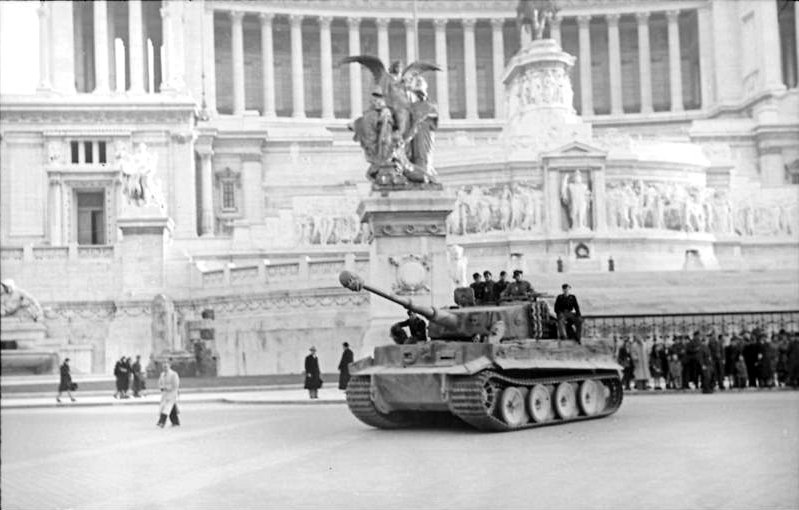
A Tiger from sPz.Abt. 508 in Rome, near Vittoriano palace in February 1944. This unit, 45 Tigers strong, was sent to attack the bridgehead at Anzio and soldiered in Italy until February 1945 - Credits: Bundesarchiv.
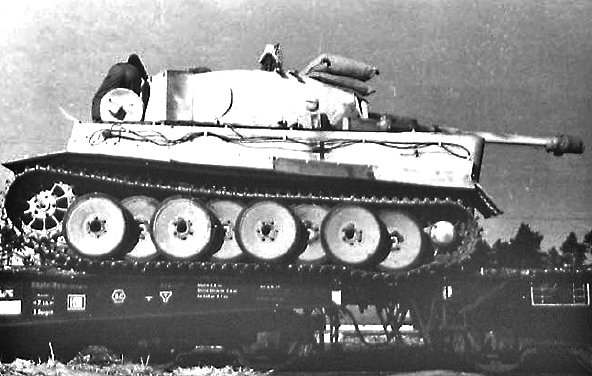
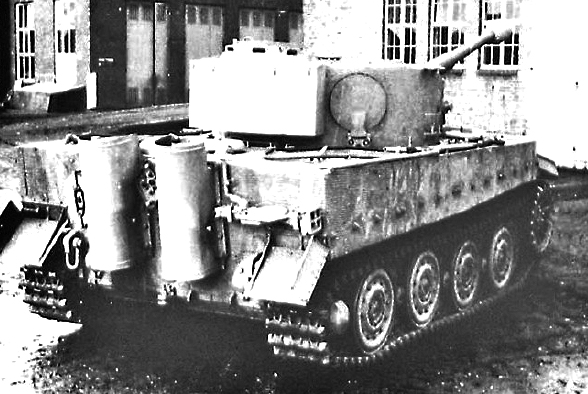
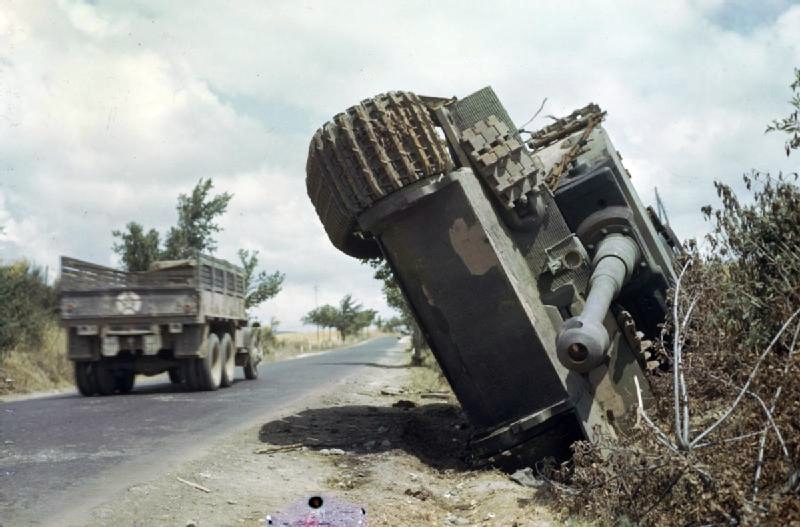
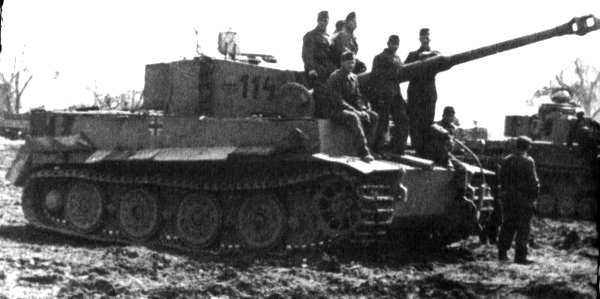

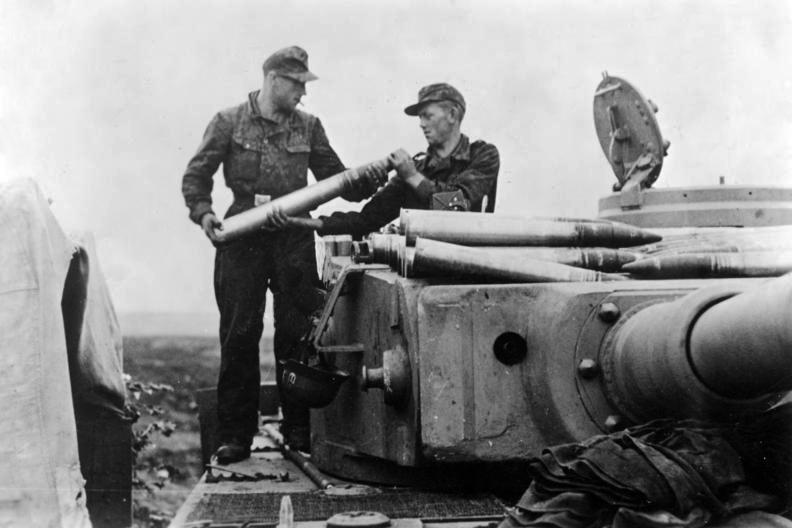
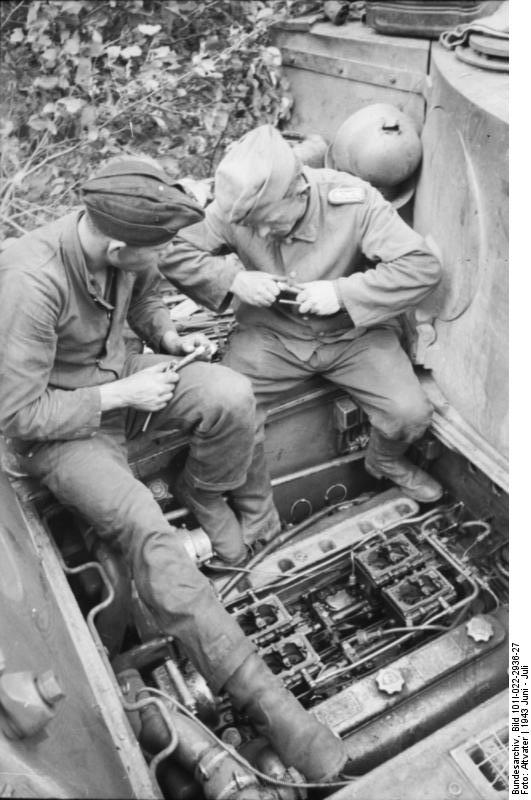
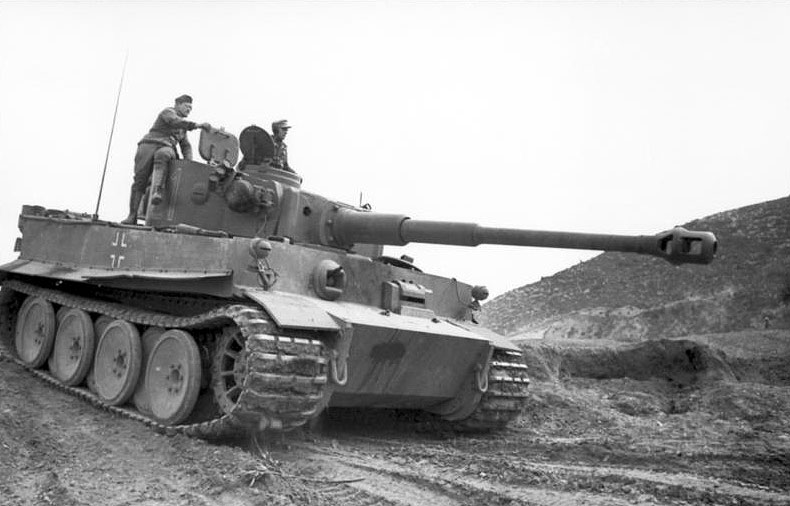
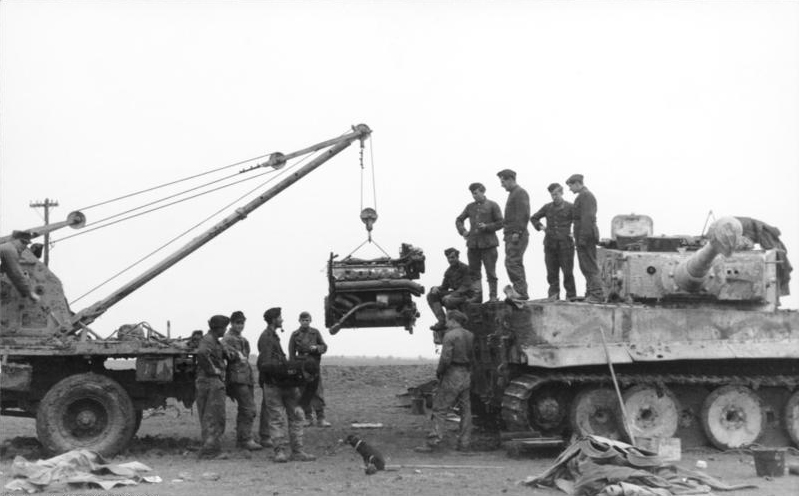
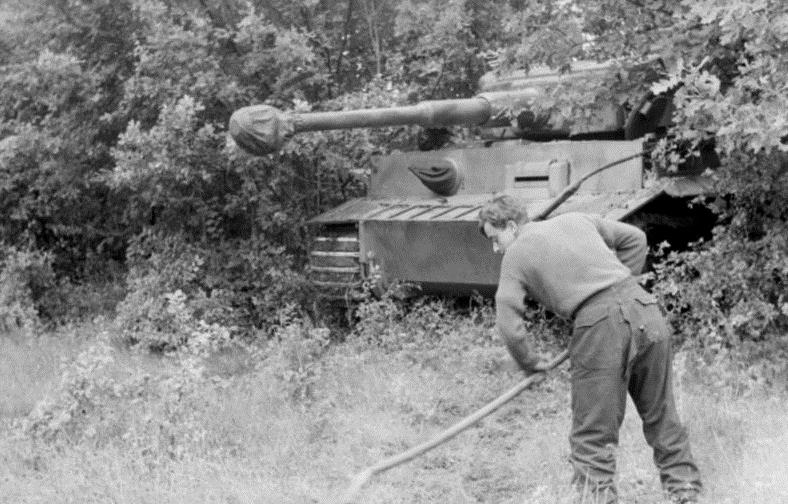
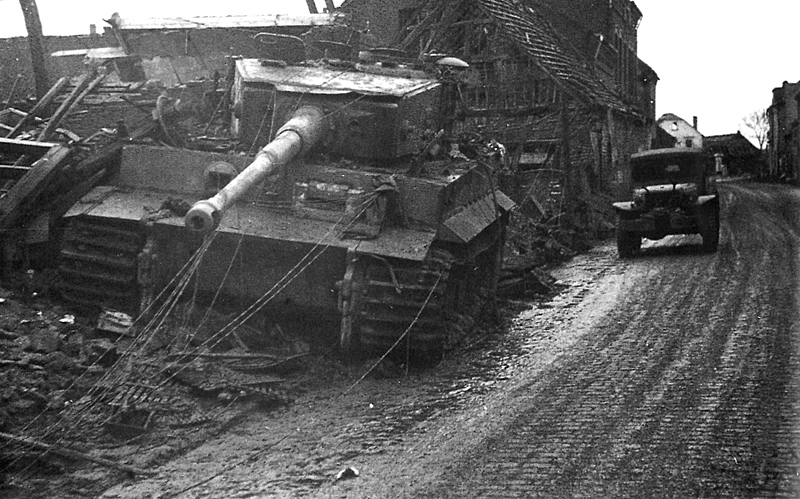
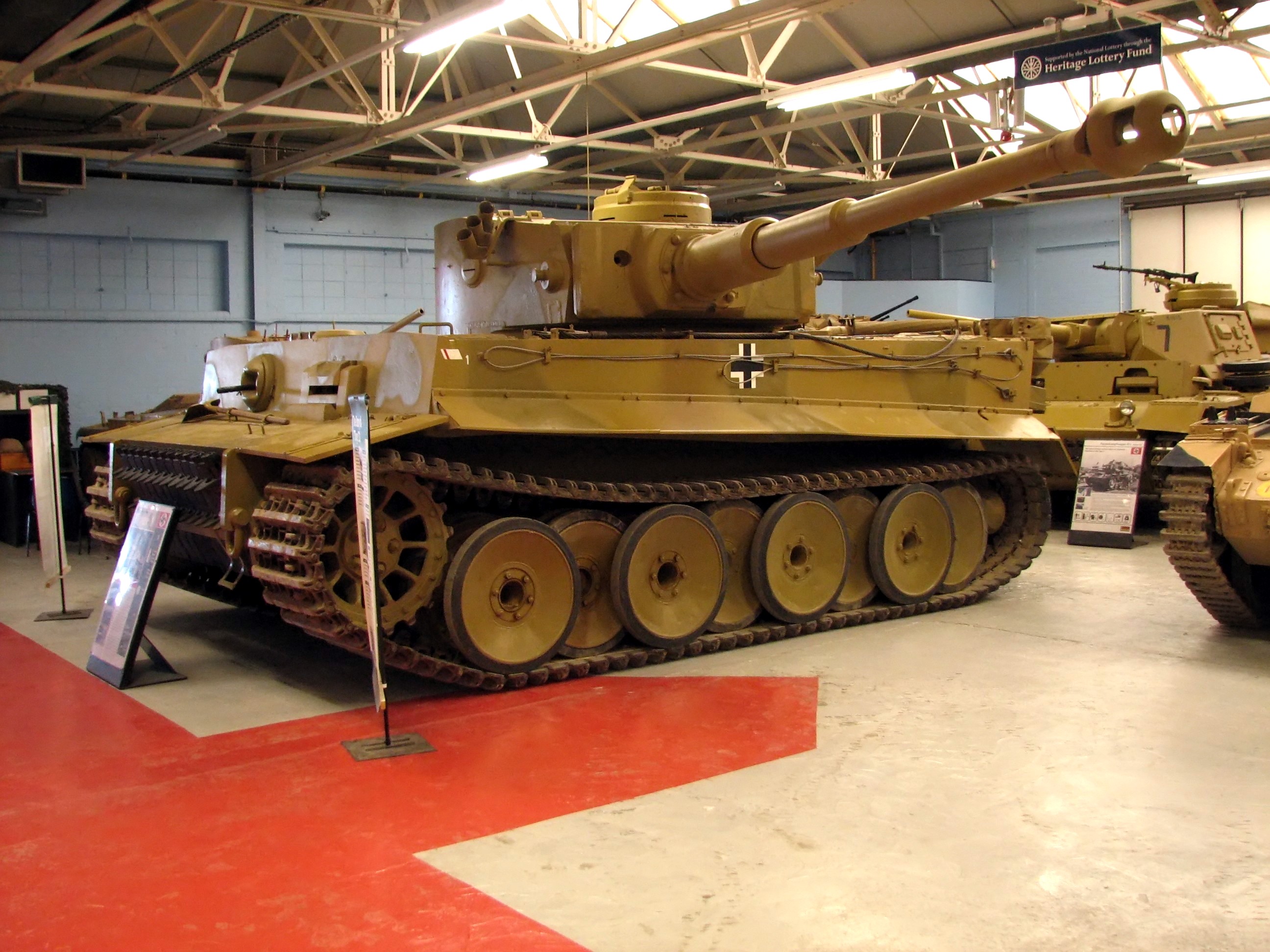
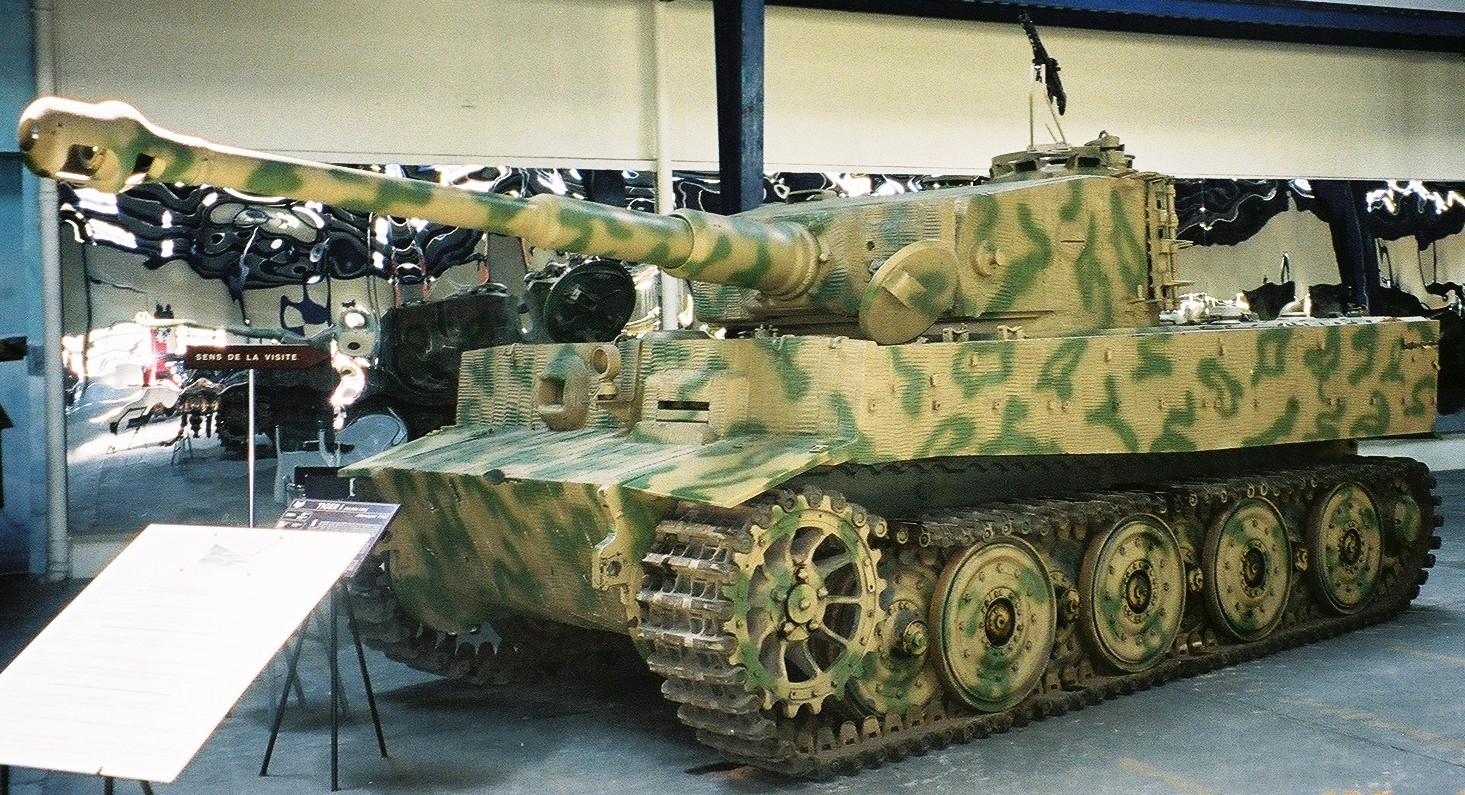
Ferdinand_Elefant_Aberdeen_ProvGrounds.jpg)
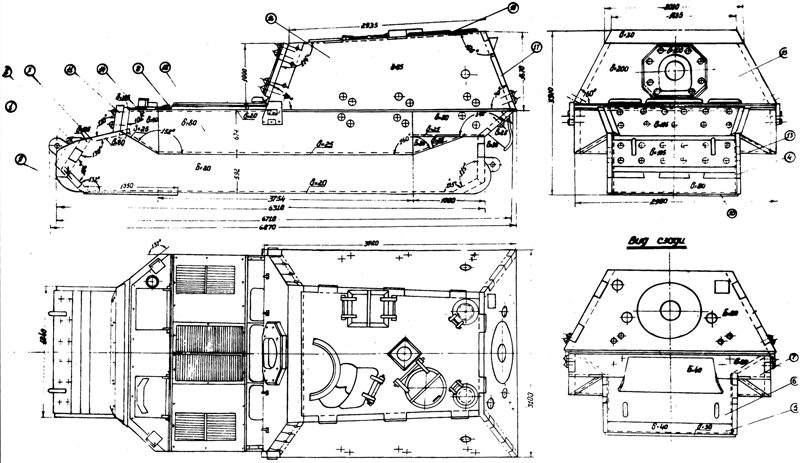
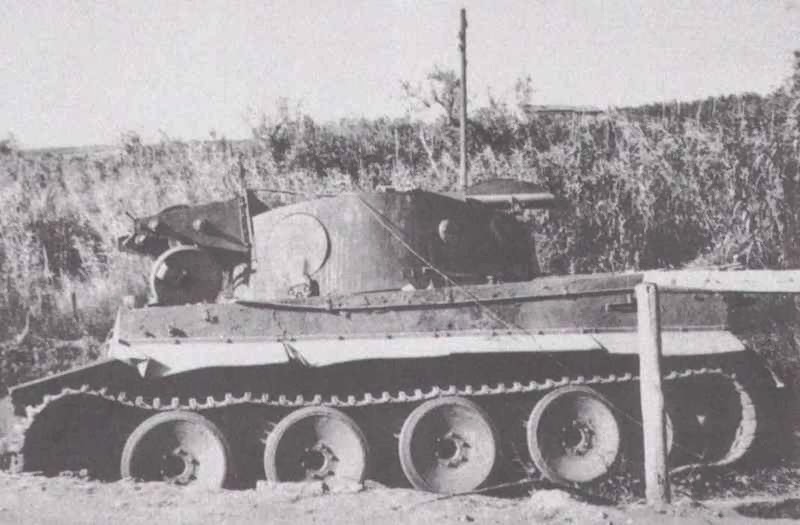
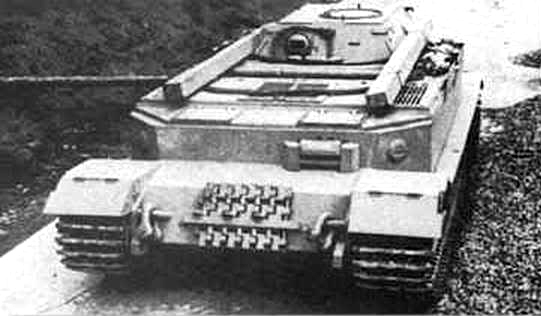
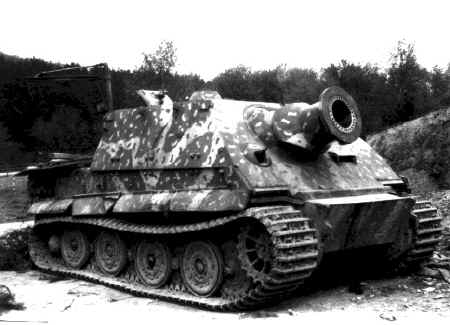
Youtube Documentary

Germans Tanks of ww2
Prototypes
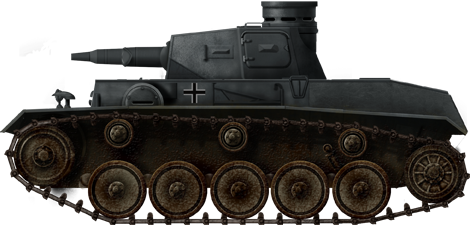
Prototype DW 2 (Durchsbruchswagen II), as delivered with the Krupp Turm (1940).

Prototype VK 36.01 chassis, Kummersdorf testing ground, fall 1941.

Prototype VK 45.01 (1942), Porsche Tiger prototype.

The only Porsche Tiger in active service with Abt.653, Ukraine, June 1944.
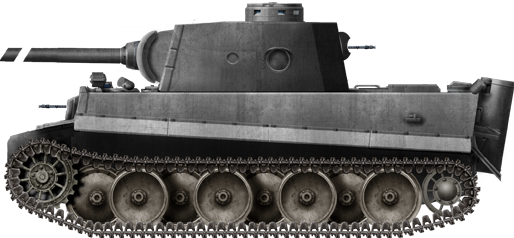
VK 45.01 H-2 prototype, as built with the Rheinmetall-Turm mit 7.5 cm (2.95 IN) KwK L/70. The turret reminds of the Panther Turm and had side pistol ports and an emergency escape hatch on the right side, communication port on the left side, and machine-gun ball-mount on the rear.
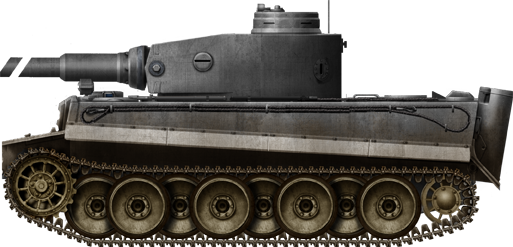
Panzer VI Tiger Ausf.H-1 Vorpanzer Fgst.Nr.V1, after being equipped with the new armor guards and without the mudguards.
Serial production
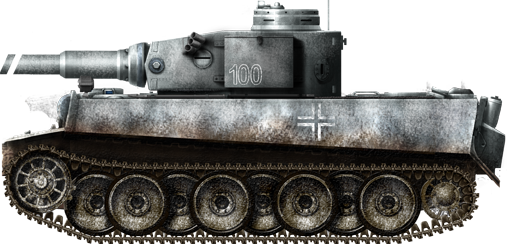
Tiger Panzerbefehlswagen Ausf. H-1, used by Pz.Abt.501, Leningrad sector, September 1942.
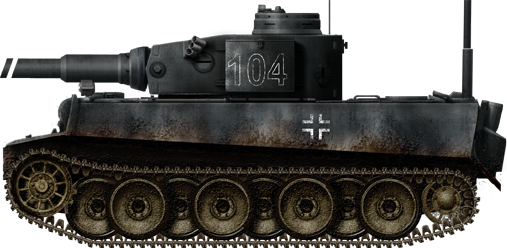
Tiger Ausf.H-1, early production, testing the schnorchel with Panzer Abteilung 502, Leningrad sector, January 1943.
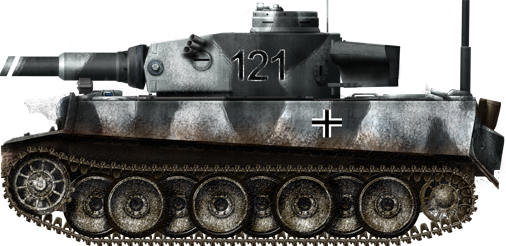
Tiger Ausf.H Frühes Modell mit Snorkel, Schwere Panzer Abteilung 501, Russia, January 1943.

Panzerkampfwagen Tiger Ausf.H/E Frühes Modell (early production), 8th Kompanie SS Panzerdivision"Das Reich", Russia, April 1943.
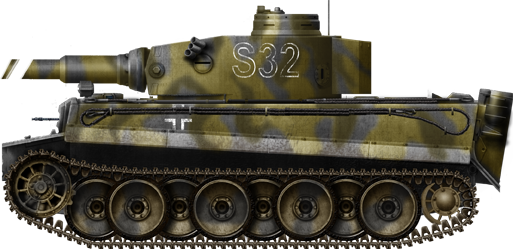
Tiger Ausf.H/E Frühes Modell from another unit of the SS Panzerdivision "Das Reich", Russia, January 1943.
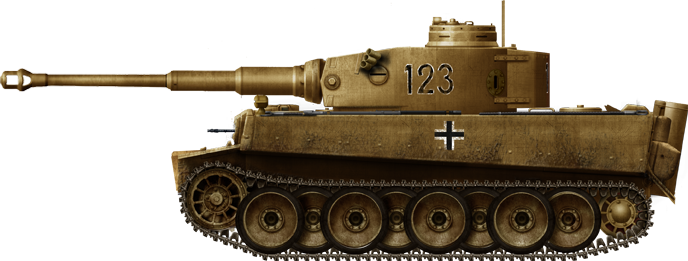
Tiger Ausf.E(T), first batch sent to Tunisia, sPz.Abt. 501, November 1942.
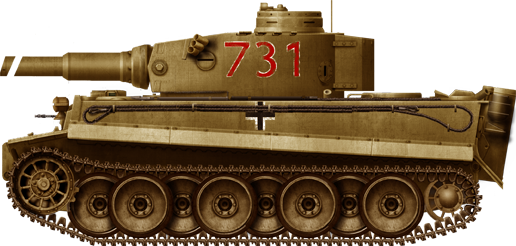
Tiger Ausf.E(T), for "Tröpische" Frühes Modell, from the 7th Kompanie sPz.Abt. 501, Tunisia, April 1943.
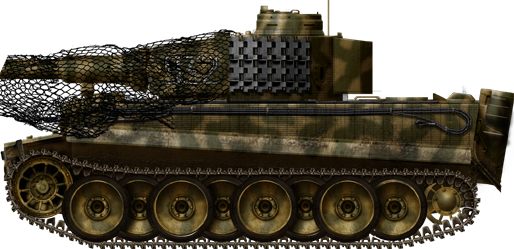
Ausf.E early type, 3rd SS. Panzergrenadier Division, Kursk, summer 1943.
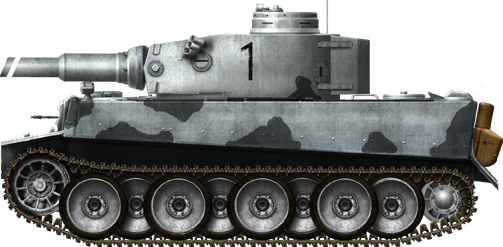
Ausf.E (early) from the Schwere Panzer Abteilung 502 in Russia, September 1943.
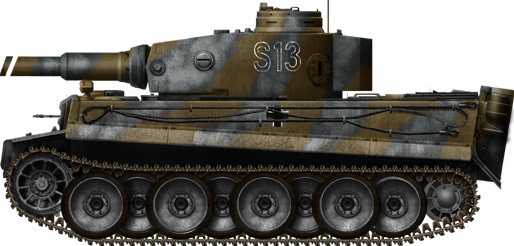
Ausf.E, early version, 2nd SS Panzergrenadier Division, Eastern front, fall 1943.
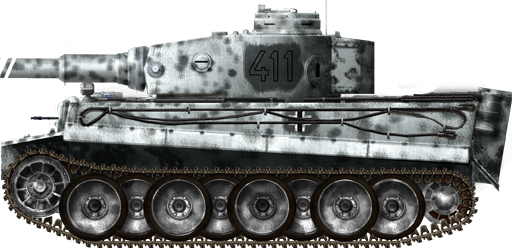
Ausf.E from the 1st Schwere SS Panzergrenadiers at Kharkov, February 1943.
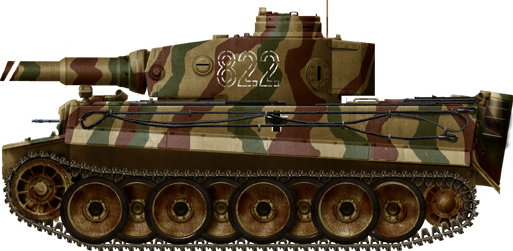
Ausf.E from the 2nd SS Panzergrenadier Division, Eastern front, spring 1943.

Ausf.E, early type, from sPz.Abt. 102, 2nd SS Panzergrenadier Division, Kharkov, May 1943. "TIKI" was the acronym of the name of the commander's girlfriend (Theresa-Katrin or Theresa-Kristine).
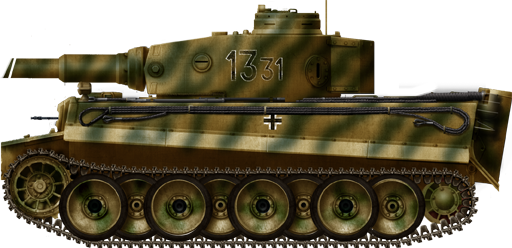
Tiger I Ausf.E, 1st SS Panzerdivision, Kharkov, April 1943.
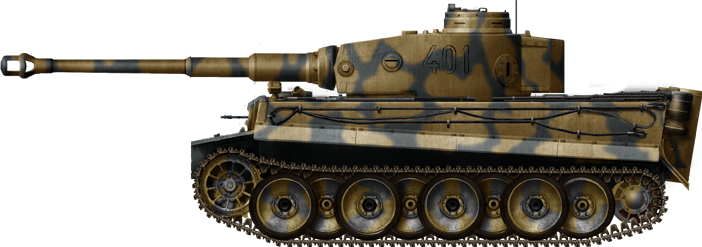
Ausf.E, early type, 1st SS Panzerdivision, Kharkov, May 1943.

Panzerkampfwagen Tiger Ausf.E early production, Schwere Panzer Abteilung 502, Southern Russia, September 1943.
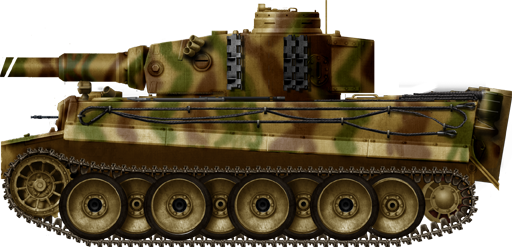
Ausf.E, early type, from the 2nd SS Panzergrenadier Division, Kursk, July 1943.
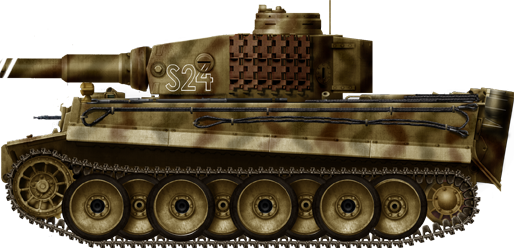
1st SS Panzerdivision, Russia, Northern Front, November 1943.
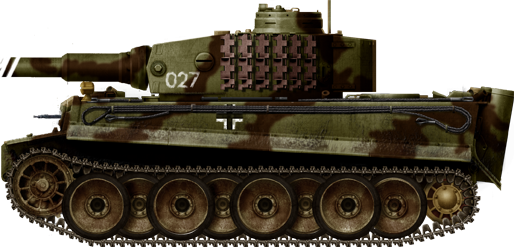
Ausf.E early production vehicle, from the sPz.Abt. 508, Italy, Anzio sector, February 1944.
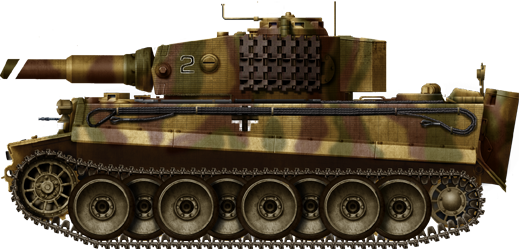 Panzerkampfwagen Tiger Ausf.E Mittlere Modell (mid-production), Schwere PanzerAbteilung 508, Italy, 1944.
Panzerkampfwagen Tiger Ausf.E Mittlere Modell (mid-production), Schwere PanzerAbteilung 508, Italy, 1944.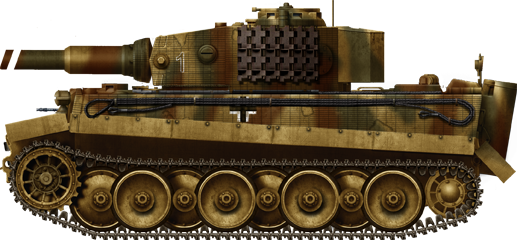
Tiger Ausf.E with Verladekette (transport narrow tracks).
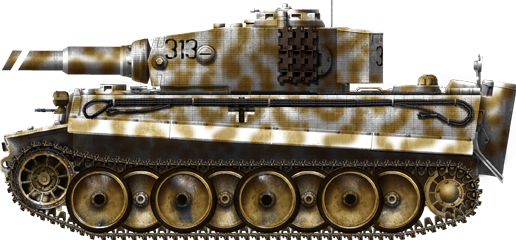
Panzerkampfwagen Tiger Ausf.E, mid production, Schwere Panzer Abteilung 502, Southern Russia, February 1944.
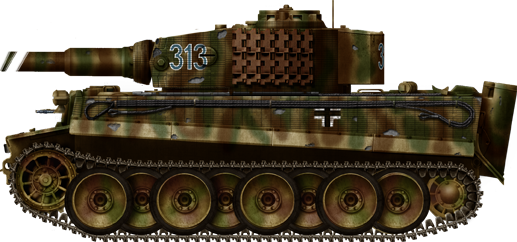
Tiger I Ausf.E, early version, SS Pz.Abt.101, Normandy, summer 1944.
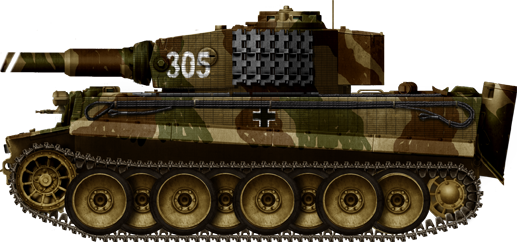
Tiger Ausf.E, SS Pz.Abt. 101, Belgium, May 1944. Notice the roughly finished camouflage.
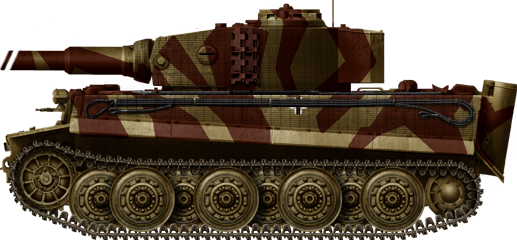
Tiger I Ausf.E, Panzer Grenadier Division Grossdeustchland, Lithuania, June 1944.
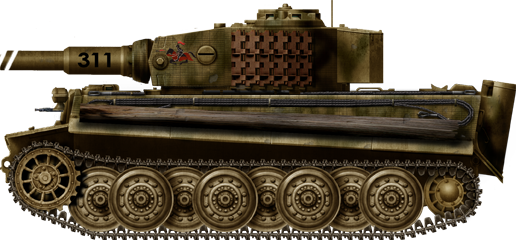
Panzerkampfwagen Tiger Ausf.E, sPz.Abt.505, Russia, February 1944.
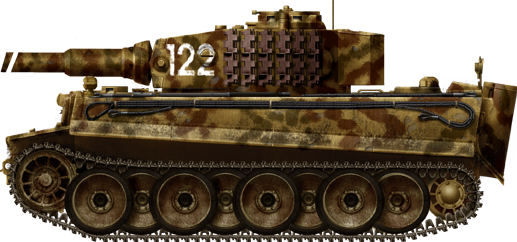
Ausf.E mid-production, 509 Schwere Pz.Abt, Russia, fall 1944.
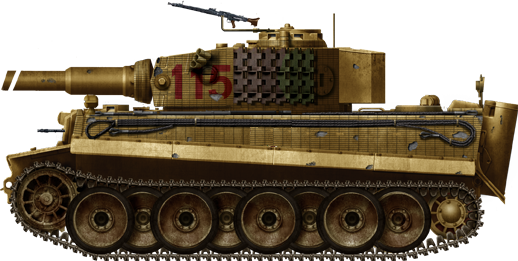
Hungarian Ausf.E from the 3rd Regiment, Ukraine, near Nadvirna, May 1944.
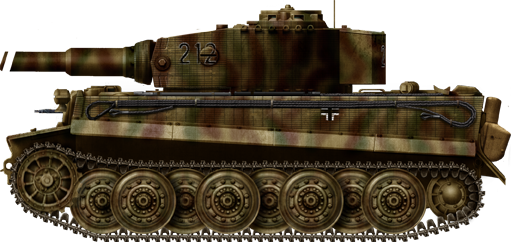 Schwere SS. Pz.Abt. 102, 2nd Kompanie, tank commander Ustuf, Normandy, August 1944. Under the command of SS Sturmbahnfuehrer Weiz, the battalion destroyed an estimated 227 tanks, 25 AT guns, 19 SPGs, 4 armored scouts and 35 trucks.
Schwere SS. Pz.Abt. 102, 2nd Kompanie, tank commander Ustuf, Normandy, August 1944. Under the command of SS Sturmbahnfuehrer Weiz, the battalion destroyed an estimated 227 tanks, 25 AT guns, 19 SPGs, 4 armored scouts and 35 trucks.
Last Tiger of Hauptsturmfuehrer (captain) Michael Wittman, one of greatest tank aces of WWII, belonging to the Schwere SS Panzer Abteilung 101. He and his crew were killed on August, 8, 1944 approximately 1 km from Cinteaux, France, presumably by a flank-firing British Sherman Firefly from the the "A" squadron, 1st Norhtamptonshire Yeomanry (part of the 33rd Independent Armored Brigade).
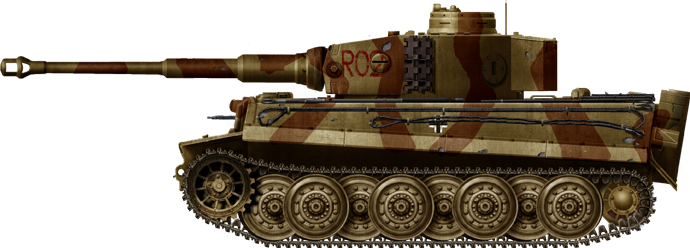
Late production Tiger with an early cupola, Fallschirmjäger Panzer Division Hermann Göring, Silesia, April 1945.

Ausf.E, late version, from the SS. Pz.Abt. 102 in Normandy, June 1944.
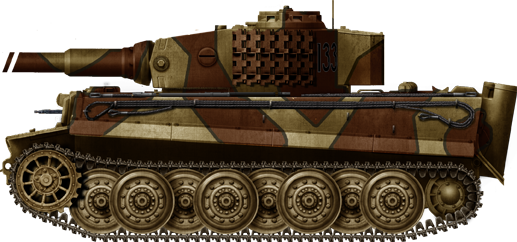
Ausf.E late Tiger with sPz.Abt. 510 in Lithuania, July 1944.
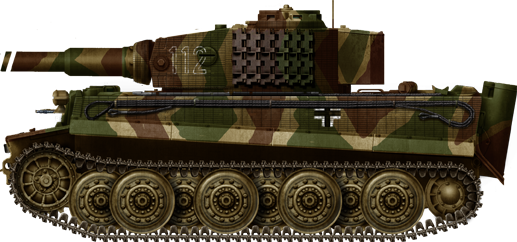
Late Ausf.E from SS Pz.Abt. 102 in Normandy, June-July 1944.
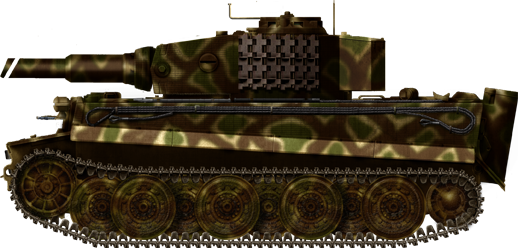
Ausf.E late, SS PanzerAbteilung 103, Holland, June 1944.
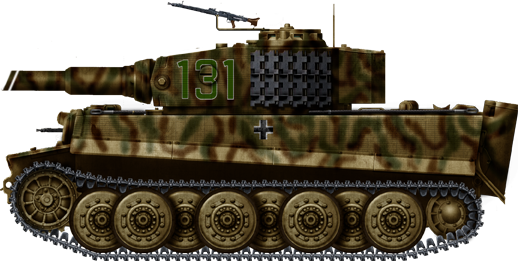
Tiger Ausf.E with metallic wheels, Hungary, early 1945.
Variants & Conversions
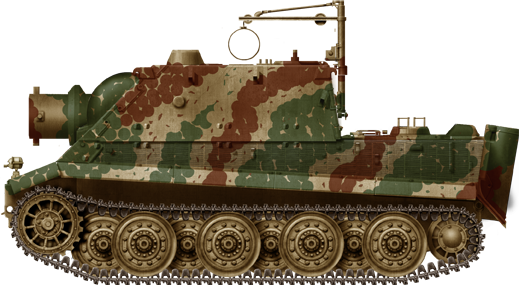
Sturmtiger or Sturmmörserwagen 606/4 mit 38 cm (14.96 in) RW 61. Only twenty were made of these Barnum-style self-propelled mortars firing one-ton 380 mm shells (14.96 in) (battleship caliber), to deal with concrete fortifications or pulverize entire building blocks in a row.
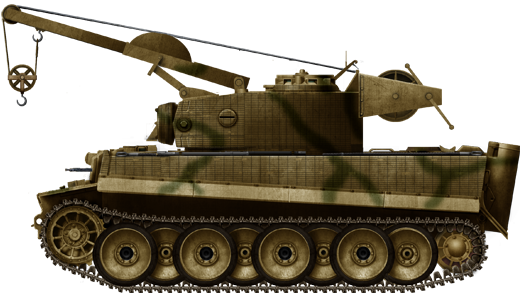
"BergeTiger" found on a roadside in Italy in 1944, it seems because of terminal engine problems. There is no record of such a name in the Waffenamt and none were found later of the same type. Whereas this vehicle was built on purpose or was a one of a kind "field experiment" or possibly three converted from gun-disabled models is today still subject to debate. Because of its excessive weight, regulations strictly forbid any attempt of towing a disabled Tiger by another one. Regulations and field experiments showed that a troika of Sd.Kfz 9 heavy half-tracks was necessary for the operation.
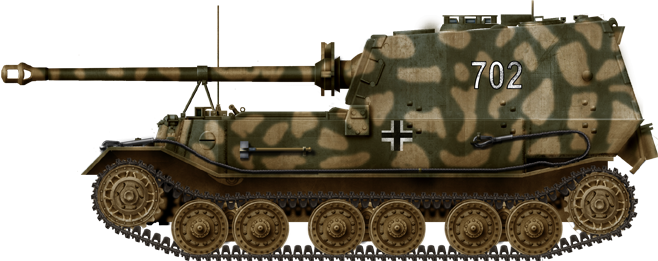
Panzerjäger Tiger (P) Ferdinand/Elefant.

WW2 Tanks




























WW2 tanks posters

All Tiger tanks liveries.

Panther liveries and variants

WW2 Armour - All tanks











Tanks aces and single tanks series

Find more there

Museums, Movies, Books & Games
The Tanks and Armor in pop culture
Tanks and armored vehicles in general are only really grasped when seen first person: The mass, the scale, it's all there. Explore also the way tanks were covered in the movie industry, in books and in video games.Movies:
Best tanks movie on warhistoryonline.com
On imdb.com
On bestsimilar.com/
miltours.com
liveabout.com/
watchmojo.com
Video Games:
pcgamesn.com
historyhit.com
levvvel.com
vg247.com/best-tank-games
mmobomb.com/
alienwarearena.com

